Articles by Andreas
Introw Raises $3M to build the future of B2B partnerships
The Ghent-based technology startup Introw, which is already helping 100+ B2B companies to boost sales through partners, has raised $3 million in a new funding round led by Visionaries Club and with the continued support from PitchDrive. Since its launch in 2023, Introw’s AI-powered partner platform has facilitated tens of thousands of partner interactions and helped clients generate millions in additional pipeline.
The company had previously raised €1 million from Pitchdrive and angel investors including Pieterjan Bouten (Ex-Showpad) and Ewout Meyns (Ex-HubSpot).
From Local Studio to International Growth
Founders Andreas Geamanu (CEO), Laurens Lavaert (CTO), and Simon Van Den Hende (Head of AI) started Introw in early 2023, originally incubated by StarApps, the venture studio of serial entrepreneurs Lorenz Bogaert & Nicolas Van Eenaeme, also known as the “Netlog mafia.”
2025 has been a breakthrough year for Introw: the team grew from 4 to 15 people, and revenue quadrupled.

AI-Driven Partner Enablement
Buyers now expect highly personalized experiences, yet outreach fatigue and tighter privacy regulations have made it harder for direct sales teams to cut through the noise. That’s why an increasing number of companies are turning to partner sales (indirect sales) as these already have relationships, credibility, and access to customers.
Introw’s AI-powered partner portal enables companies to onboard, train, and activate partners in minutes. Unlike legacy systems that take months to deploy, Introw connects instantly to your CRM, giving partners access to customer data, and sales tools to close more deals.
“Each day a partner lacks the right information, means lost revenue. Where other partner portals take four to six months to launch, we do it in minutes.” says CEO Andreas Geamanu.
Visionaries Club Backs a Fast-Growing Success Story
Visionaries Club, which previously invested in tech companies such as Lovable, n8n, and the Belgian Accountable (recently acquired by Visma), sees huge potential in Introw.
Partnerships drive a huge share of global B2B revenue, yet most teams still manage them with spreadsheets and outdated tools. Introw is changing that with a platform built for speed and simplicity.” said Robert Jäckle, Partner at Visionaries Club. “The team is creating the first truly intelligent partner system, turning partnerships from a ‘nice-to-have’ into a real growth engine. We’re backing them because they move fast and have the ambition to own this category
Becoming the Market Leader in Partner Enablement
A large share of Introw’s revenue already comes from the US, where the company is seeing accelerating traction. With this new funding, Introw is scaling its sales and marketing presence and doubling down on its AI-first vision.
The mission is clear: To become the global leader in AI-driven partner enablement and redefine how companies grow through partners.
About Introw
Founded in 2023 and based in Ghent, Introw is redefining how companies sell through partners. The platform empowers B2B organizations to onboard, train, and enable their partners globally through an AI-powered partner portal.
By deeply integrating with a company’s CRM, Introw enables seamless collaboration between internal sales teams and external partners, ensuring everyone has access to the right data, context, and tools to close deals faster.
Already used by 100+ companies across more than 30 countries such as Factorial, Parloa & Coder, Introw helps organizations transform partnerships into a scalable revenue engine.
About Visionaries Club
Visionaries Club is a leading European early-stage VC with offices in London and Berlin, focusing on B2B with its flagship seed and early-growth funds, alongside its industrial deeptech fund, Visionaries Tomorrow. Visionaries unites the strongest network of successful tech founders together with the family entrepreneurs behind global industrial businesses in a single LP community to supercharge the next generation of category-defining software and AI giants. It counts Personio, Lovable, Miro, Pigment, Accountable, n8n, Tacto, Apron, Choco and Xentral among its portfolio companies.
(Fun)ding video
We love building and hustling, but we also love to have some fun. Enjoy the video (powered by Hooked Visuals) 😜.
Top 15 Impact Alternatives for Effective Partner Management in 2025
Impact is a partnership management platform designed primarily for affiliate, influencer, and performance marketing programs.
It can be a handy tool if your business relies heavily on affiliates and influencers to generate sales.
However, if your partner program is broader in scope – perhaps your strategy is more channel-focused, for example – you’ll benefit from a more comprehensive partner relationship management (PRM) platform.
Ready to kick your partner management up a gear this year? Read on for our 15 top Impact.com alternatives in 2025.
Why Consider an Impact Alternative in 2025?
An end-to-end performance marketing tool, Impact excels at affiliate and influencer programs because that’s what it’s designed for.
However, there are four major areas in which SaaS outstrips this online platform.
1. Limited CRM-Native Channel Workflows
Modern SaaS platforms like Introw work on top of your CRM, enabling seamless logging, tracking, and reporting directly inside Salesforce or HubSpot.
This deep embedding provides sales teams and all their partners with real-time visibility, eliminating the need to switch platforms.
However, Impact is browser and app-based, and requires teams and their partners to operate largely outside the CRM, which can create friction in channel workflows.
2. Deal Registration & Co-sell Motions Vs Affiliate Tracking
While Impact is certainly strong on affiliate tracking and commission management, it doesn’t fully support deal registration and co-sell motions.
Affiliate link tracking is primarily focused on click attribution, but SaaS functionality goes deeper, enabling joint selling motions, more meaningful collaboration, and improved pipeline visibility.
Indeed, try out a modern SaaS platform and you’ll generally find a structured deal registration pipeline, where partners can submit opportunities, collaborate with sales teams, and track progress through the funnel.
3. Off-portal engagement
Impact relies heavily on its portal for communication with partners.
In contrast, modern SaaS solutions meet partners where they already work – for example, email, Slack, or other collaboration tools.
What’s more, in 2025, this off-portal engagement is mostly automated, delivering updates surrounding deal stages, approvals, or payments into partners’ daily workflows.
And when it comes to saving time and boosting engagement, you can't beat automated outreach.
4. Attribution & Forecasting
Impact will track conversions and clicks, but SaaS platforms will typically offer more robust attribution and forecasting capabilities than this.
Indeed, SaaS tools directly tie partner activities to pipeline metrics, making it clear how each partner impacts revenue.
This makes strategic planning and forecasting much easier.
➡️ This is why, if your B2B partnerships include referral, reseller, or co-sell, it’s worth considering a CRM-first alternative to Impact. Learn more about Introw here, or read on for more information on shopping for the best alternative.
What to Look For in an Impact Alternative
Considering swapping Impact for a modern PRM?
Here’s what you should be looking for when it comes to choosing your next PRM.
- CRM-first: Look for a PRM that integrates directly with your CRM, so partner records, fields, and reporting live natively in Salesforce or HubSpot.
- Deal Registration & Co-sell: Your new PRM should support seamless deal registration and co-selling by enabling a shared pipeline, mutual action plans, and conflict prevention.
- Off-portal Engagement: Forcing partners to log into a portal every time they need a quick update will put you on a fast track to disengagement. Instead, prioritize a PRM that delivers automated updates and alerts in channels they already use, such as email or Slack.
- Automation: Automation is a must-have in 2025. These tools help you launch and optimize campaigns, onboard partners, engage partners, send activity reminders and prepare for QBRs much more quickly, and with much less manual labour, than in the past.
- Attribution: Make sure your new platform provides clear attribution, from partner engagement through to pipeline and revenue impact.
- Partner UX: Your PRM must deliver a frictionless experience, making the user journey as easy as possible for your partners. Look out for features like a simple submission process, easy access to branded assets, and self-serve tools.
- Scale & Security: As your partnership program grows, you’ll need to be able to easily manage different partner tiers, regions, and types. Choose a PRM with strong security and role-based access controls.
The 15 Best Impact Alternatives for SaaS Partner Programs (2025)
If you’ve been using Impact, but are keen to see what other alternatives could offer you, you’re in the right place.
Here’s our pick of the 15 best Impact alternatives on the market in 2025.
1) Introw
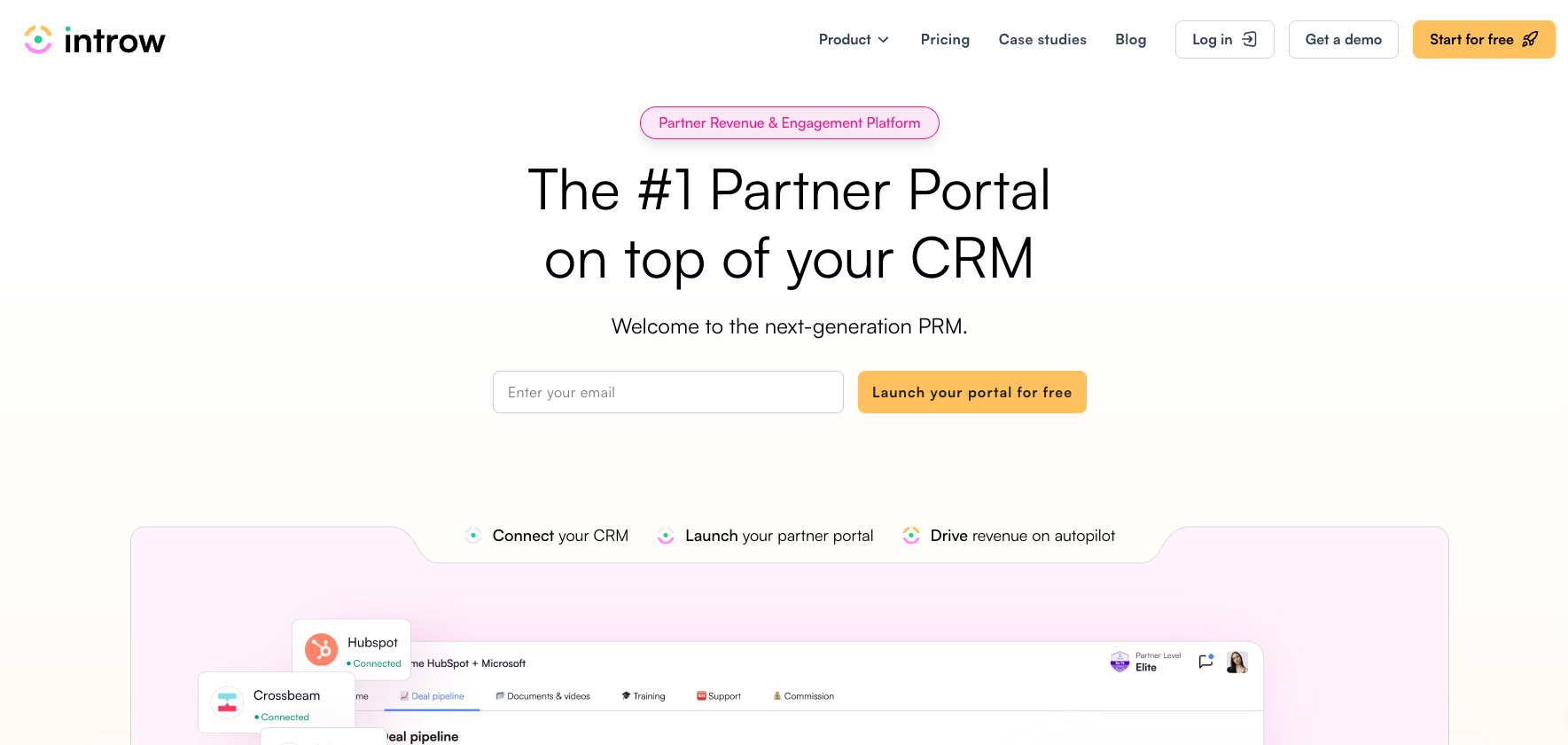
A CRM-first PRM designed for SaaS, Introw is perfect for teams that already use Salesforce or HubSpot, and are running referral, reseller, and/or co-sell programs at scale.
So, why should you choose Introw over Impact?
Introw is purpose-built for channel partnerships — with CRM-native, partner-first workflows that streamline co-selling and co-marketing across your ecosystem.
It embeds deal registration, co-sell updates, and engagement tracking directly inside your CRM, while off-portal updates via email and Slack keep partners engaged without forcing them to log into another tool.
Key capabilities:
- Campaign management features
- Partner engagement analytics (visits, content usage, opens/clicks)
- Outreach automation including automated deal updates
- White-labeled experiences
- Role-based dashboards
- Integrates with Salesforce, HubSpot, Slack
- Responsive customer support
🚀Ready to take your partner program to the next level? Request an Introw demo here.
2) PartnerStack
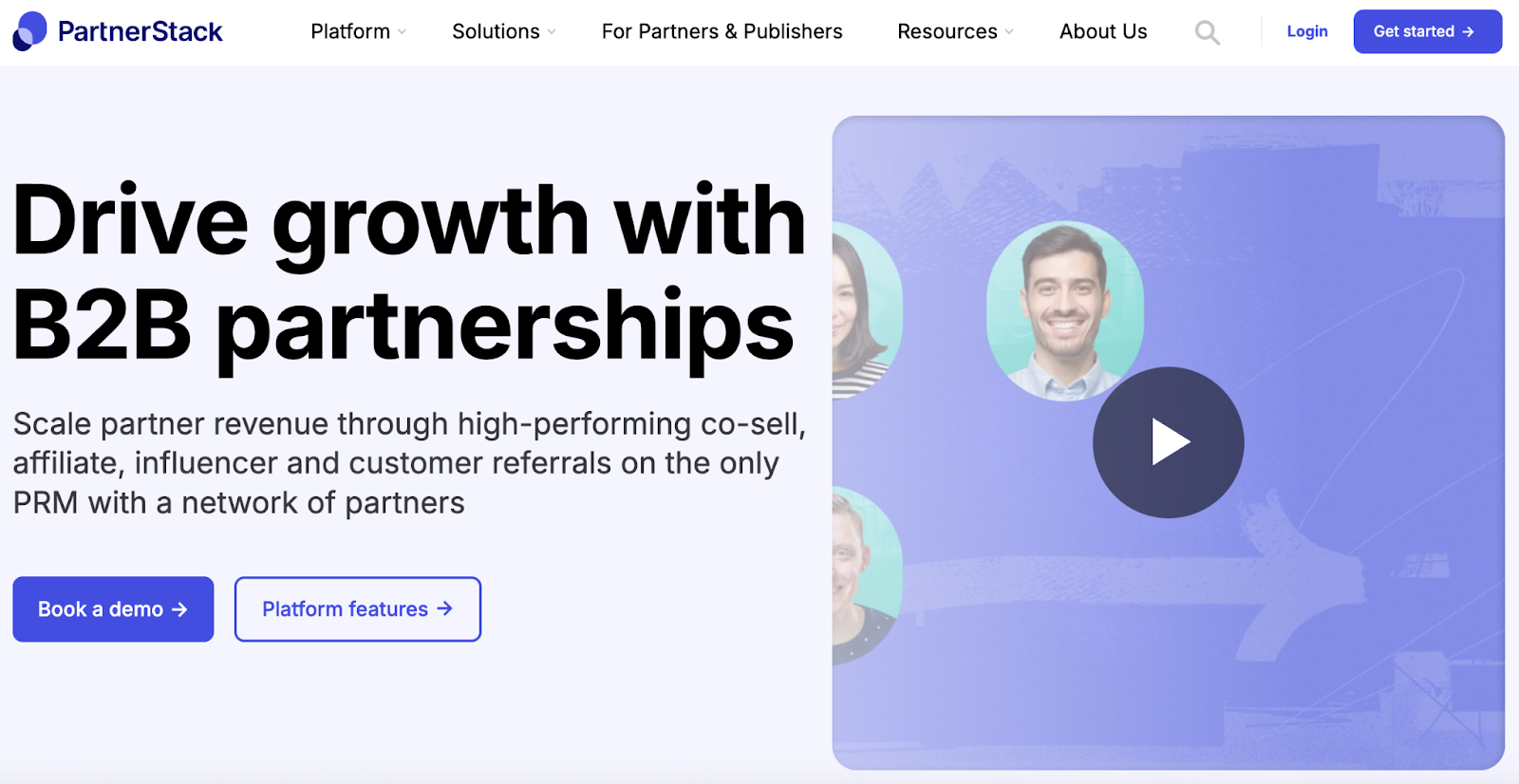
Looking to combine affiliate programs, referral marketing, and reseller partners while gaining marketplace reach?
Take a look at PartnerStack.
Unlike Impact, which is primarily affiliate-focused, PartnerStack is built with SaaS go-to-market strategies in mind and extends well beyond affiliate-only use cases.
Please note that PartnerStack is not CRM-native, so advanced co-sell programs may require additional tools.
Key capabilities:
- Partner marketplace
- Payouts
- Referrals/reseller workflows
💡Looking for some great PartnerStack alternatives? Here are some of the best.
3) Kiflo
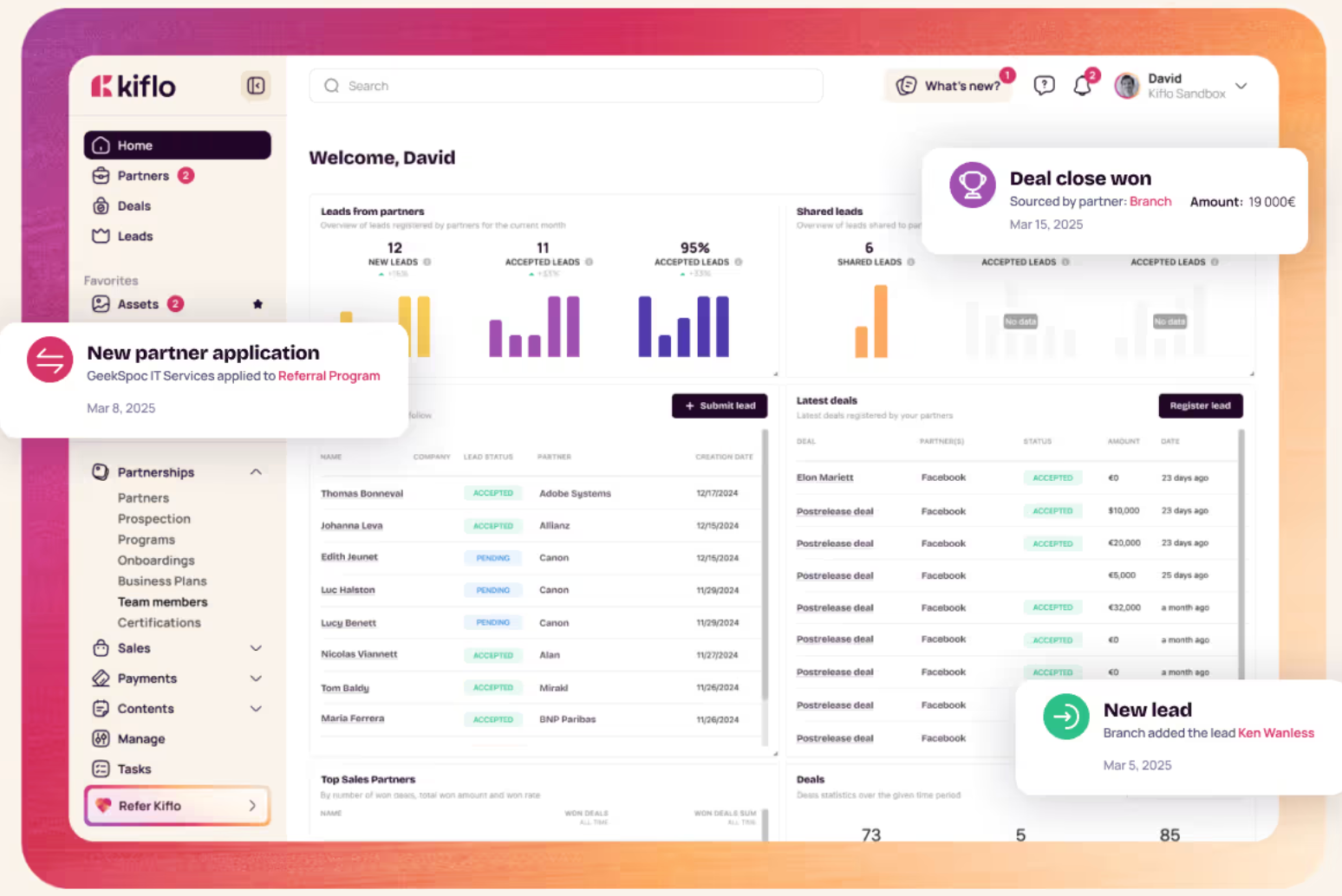
Kiflo is a PRM that works well for small to mid-market SaaS companies just starting their formal channel or partner programs.
This platform offers a lighter-weight PRM approach compared to Impact, making it easier for companies to launch and manage reseller or referral programs.
However, bear in mind that it has limited enterprise-grade analytics and deep CRM workflows, so it’s much better suited to smaller businesses looking for a simpler solution.
Key capabilities:
- Deal registration
- Incentives
- Enablement basics
➡️ You can see our top Kiflo alternatives here.
4) Channelscaler
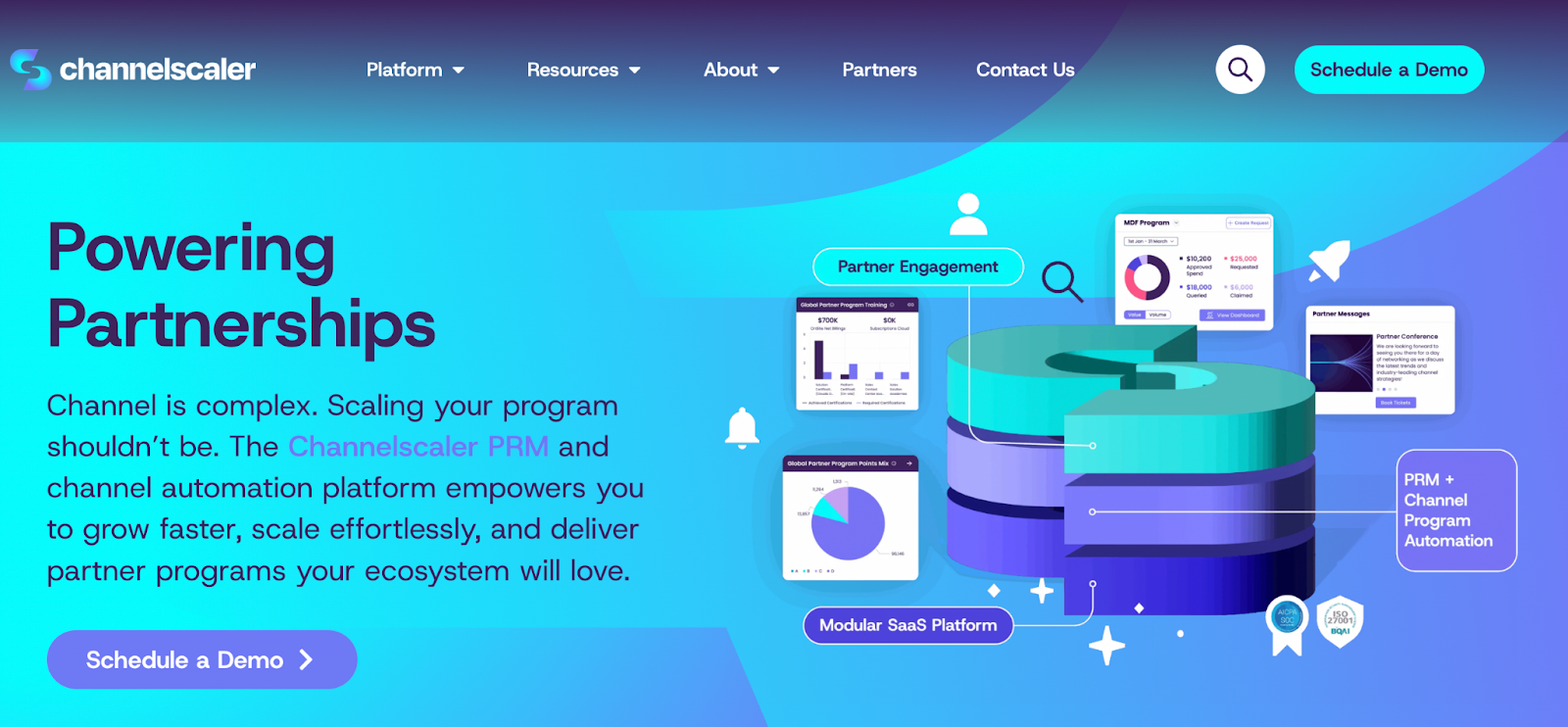
Channelscaler offers a full PRM and partner automation stack for companies running channel or partner programs.
It’s perfect for companies looking for modular solutions, but if you’re planning to run a simple program, be careful you don’t end up implementing more modules than you actually need.
How does it compare to Impact? Channelscaler delivers a channel-centric platform with a wider scope, while Impact is an affiliate-first tool.
Key capabilities:
- Deal registration
- Incentive and rebate management
- Content & enablement
- Partner journey automation
- Performance tracking dashboards
5) Impartner
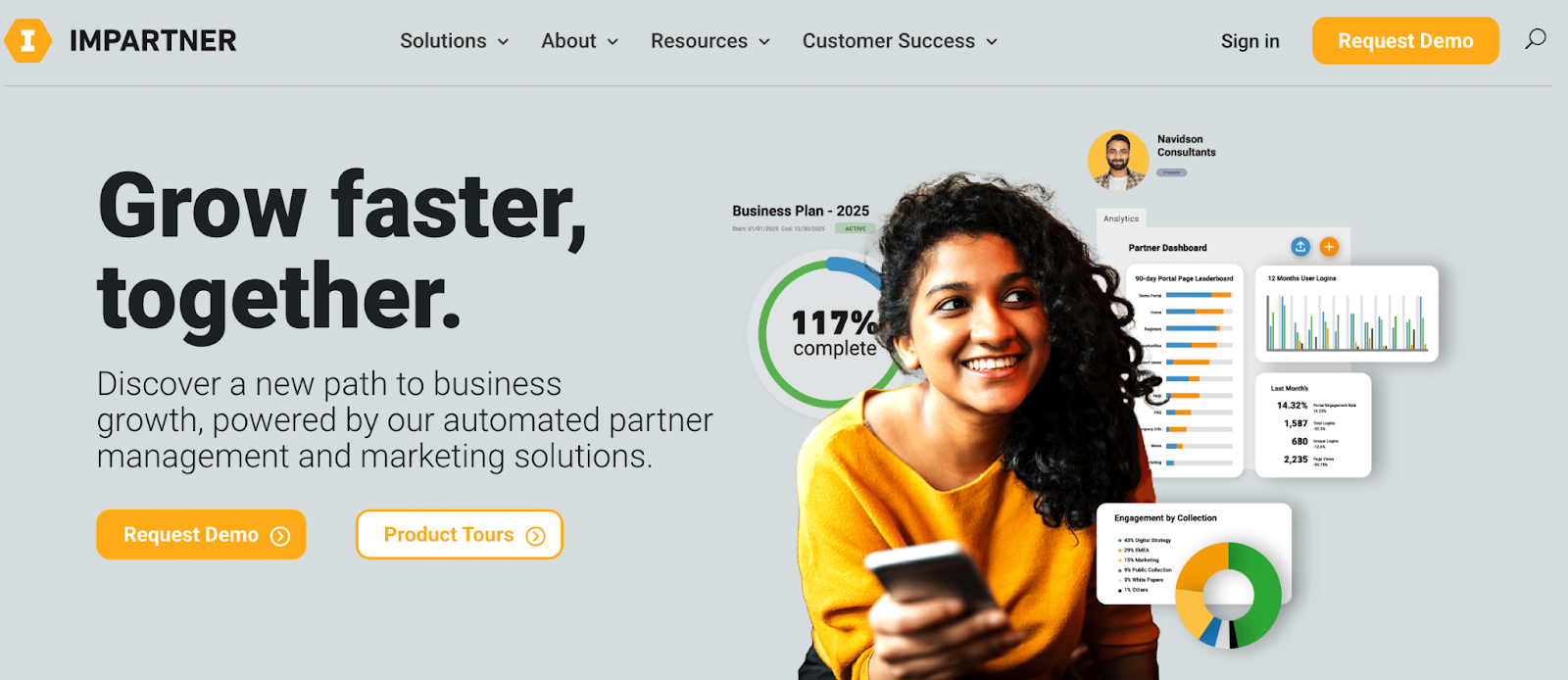
Partner marketing automation platform Impartner caters to enterprises with complex, global channel operations.
Consider this platform if you need a system robust enough to handle multiple regions, tiers, and partner types.
If you’re considering switching from Impact to Impartner, you’ll notice a huge difference: namely, that this solution provides a full-stack PRM built for deep governance and enterprise-grade scale, while Impact has a more narrow focus.
Of course, Impartner’s more complex system comes with a heavier implementation and administrative lift, so it’s vital to ensure your business has the resources to manage it effectively.
Key capabilities:
- Tiering
- MDF
- Workflows
- Robust analytics
6) Unifyr
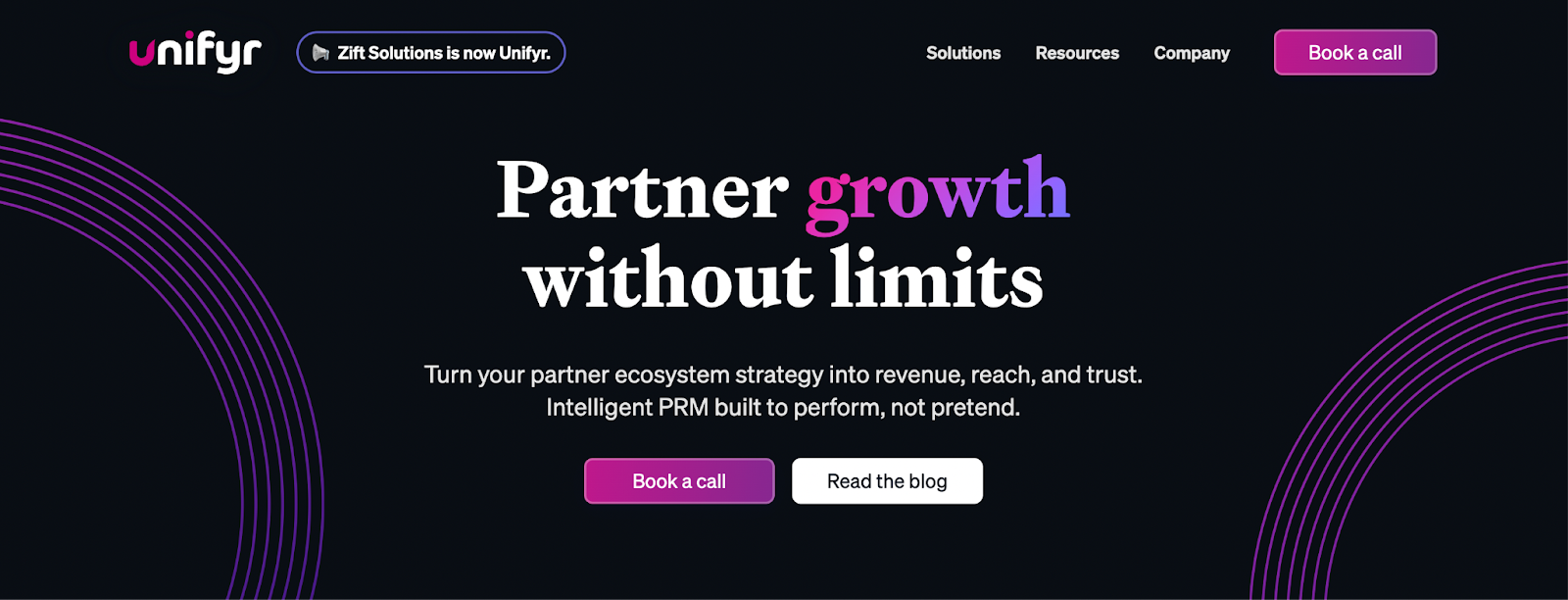
Unifyr is an all-in-one, AI-enabled PRM and channel growth platform.
It is designed for organizations managing partner ecosystems and aiming to centralize and streamline their operations, particularly in dealing with maturing or enterprise-scale channel programs.
This SaaS platform offers a wider variety of features than Impact, which focuses on performance marketing.
However, this does mean there can be a learning curve and it can be a little heavy for smaller brands, with some advanced features more applicable to mid-size or large companies.
Key capabilities:
- Partner onboarding & activation
- Deal registration & lead management
- Supplier/multi-vendor support
- AI-enabled features
7) Magentrix
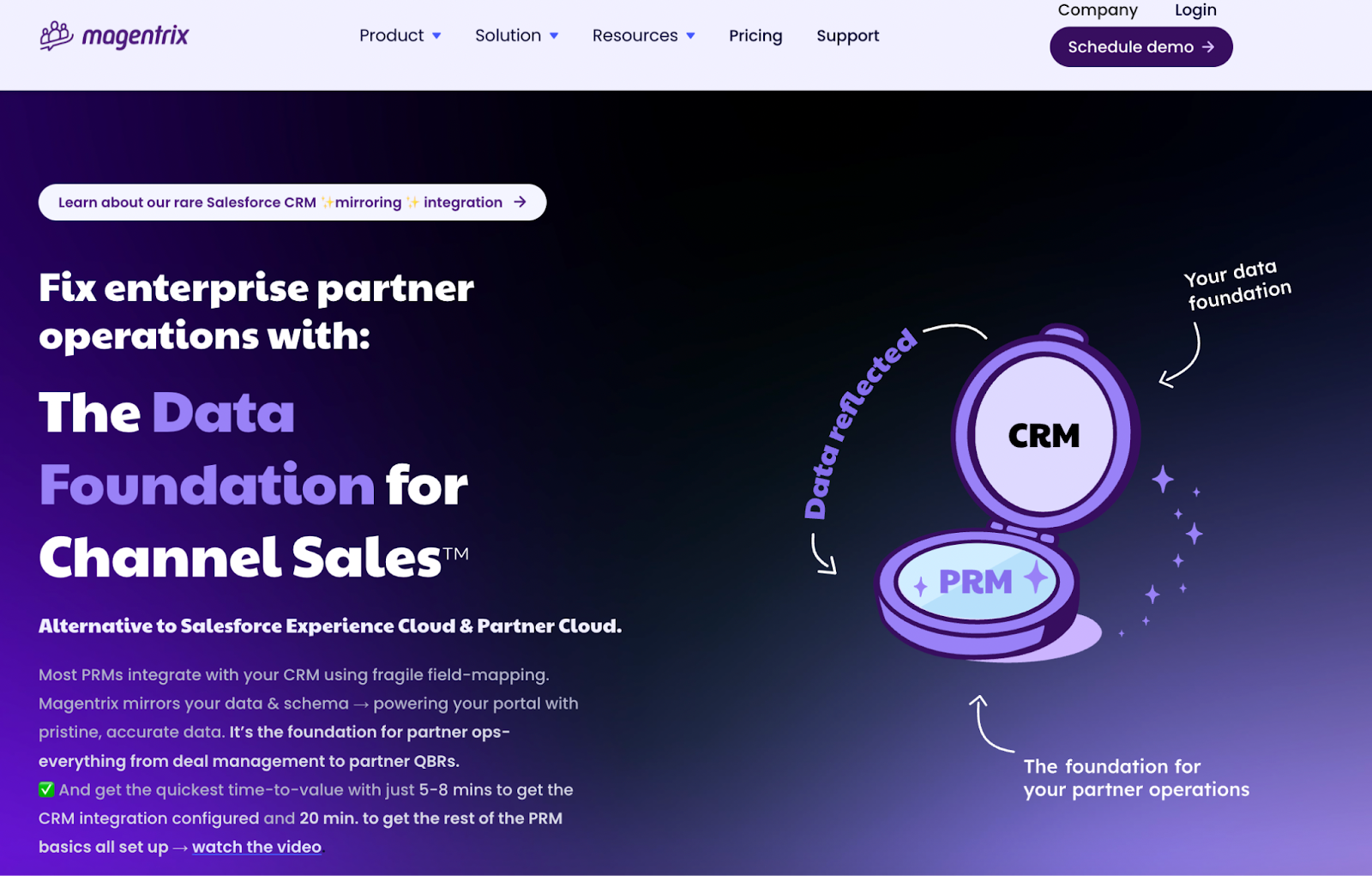
Magentrix is made for Salesforce-centric teams that need deeply integrated custom portals.
It’s a good match for teams that require close alignment between their CRM and the partner-facing portal, as well as powerful customization and scalability.
When compared to Impact, it’s worth noting that Magentrix offers deep Salesforce alignment, along with robust community and portal features that go beyond what the other platform provides.
However, since Magentrix is portal-first, it’s important to ensure that partner engagement does not rely solely on logging in.
Key capabilities:
- Resource library
- Case collaboration
- Portal UX
8) Channeltivity
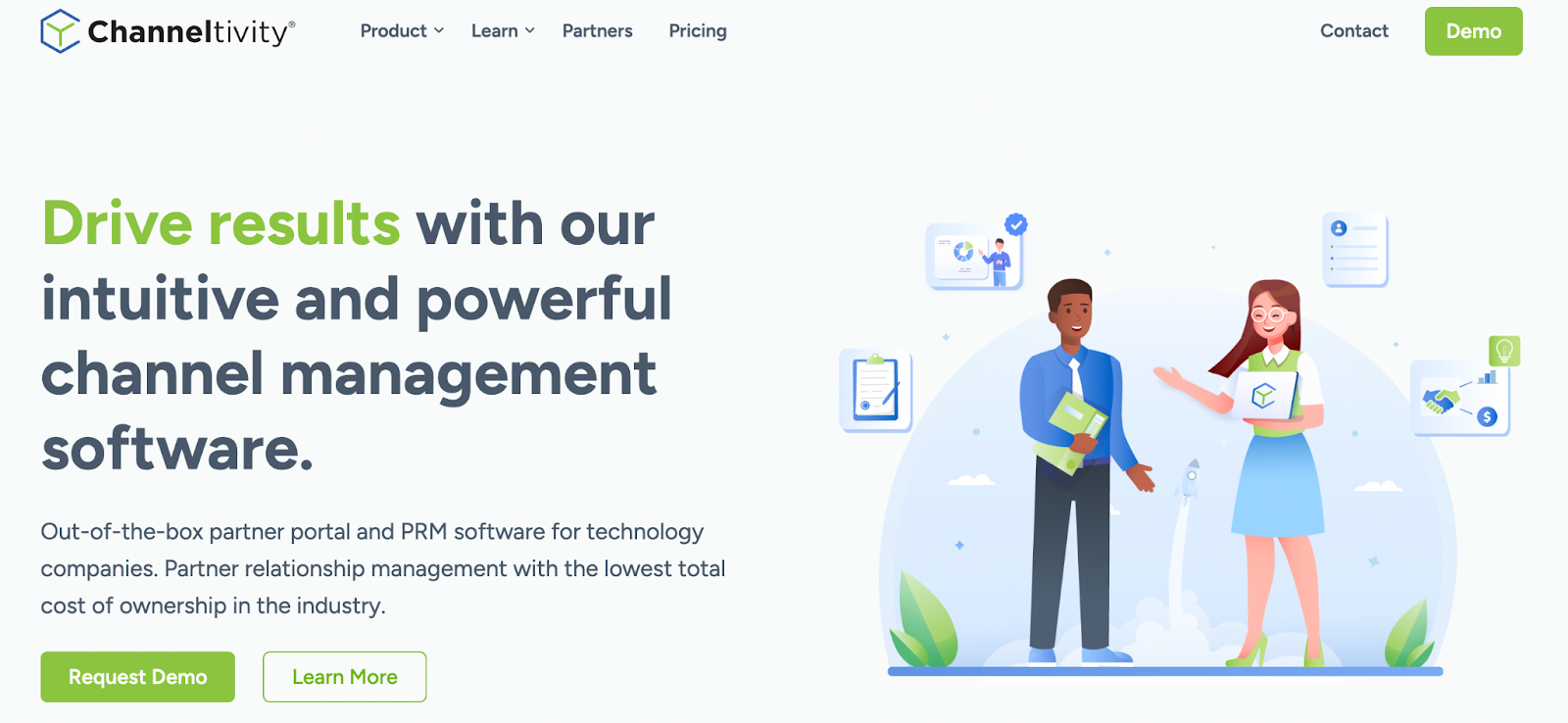
Channeltivity is designed for mid-market SaaS companies that need a comprehensive PRM to effectively manage and scale their channel programs.
This SaaS tool offers a solid foundation for channel operations, while Impact is more focused on affiliate programs.
For example, Channeltivity offers robust features, including deal registration, Market Development Fund management, and detailed reporting.
Just bear in mind that Channeltivity is primarily portal-centric, which could limit off-portal engagement.
Key capabilities:
- Partner onboarding
- Tiering
- Approvals
9) WorkSpan
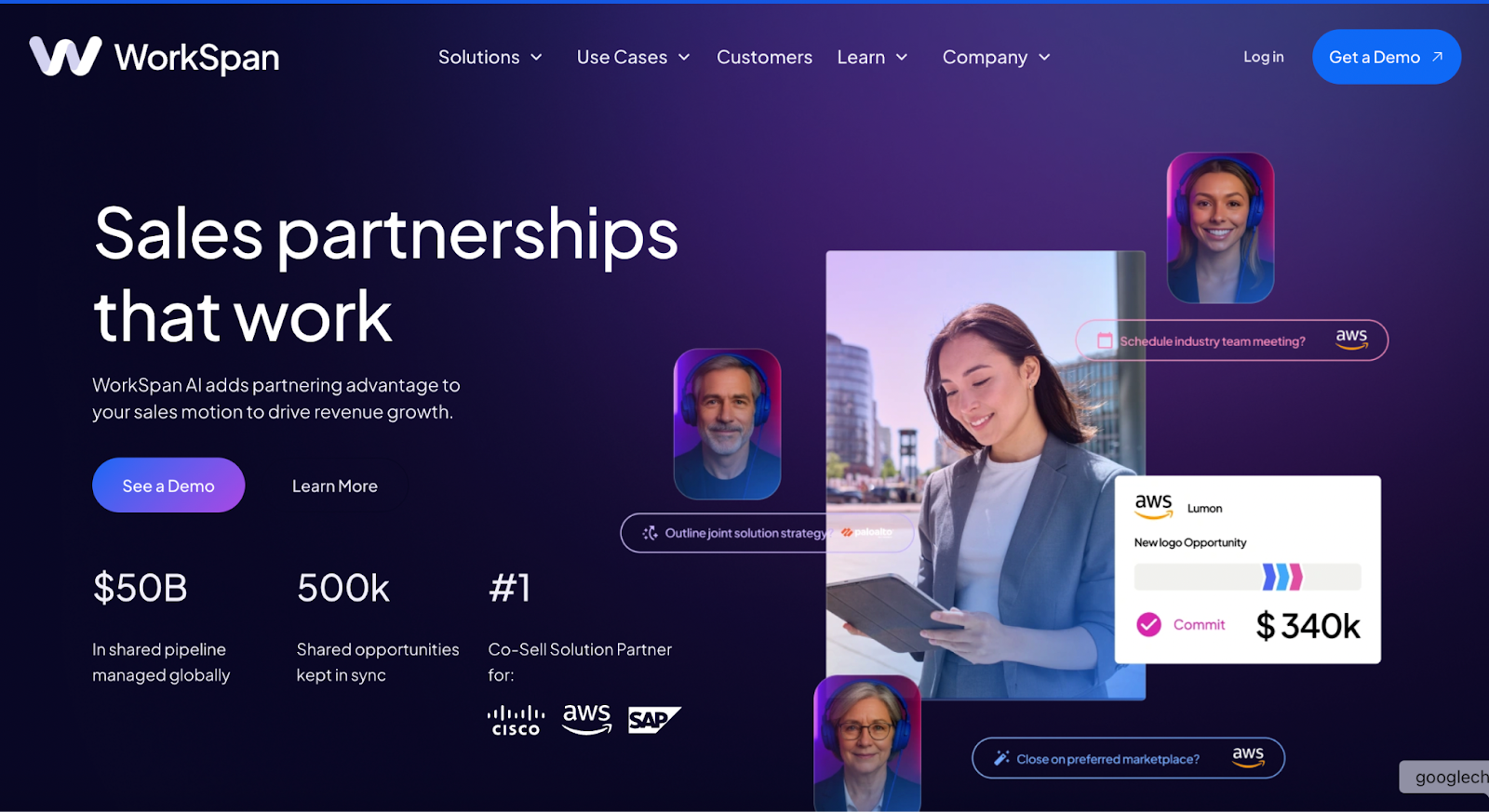
Are you tasked with managing alliance and co-sell ecosystems?
WorkSpan facilitates collaboration between multiple partners on shared opportunities and joint sales initiatives.
This solution stands out over Impact because it’s built to manage joint pipelines across partners, which helps partners to coordinate sales efforts more effectively than an affiliate-focused platform like Impact.
However, WorkSpan is not a full PRM – it’s typically used alongside a PRM or CRM to enhance partner management.
Key capabilities:
- Co-sell workflows
- Joint planning
- Pipeline tracking
10) Partnerize
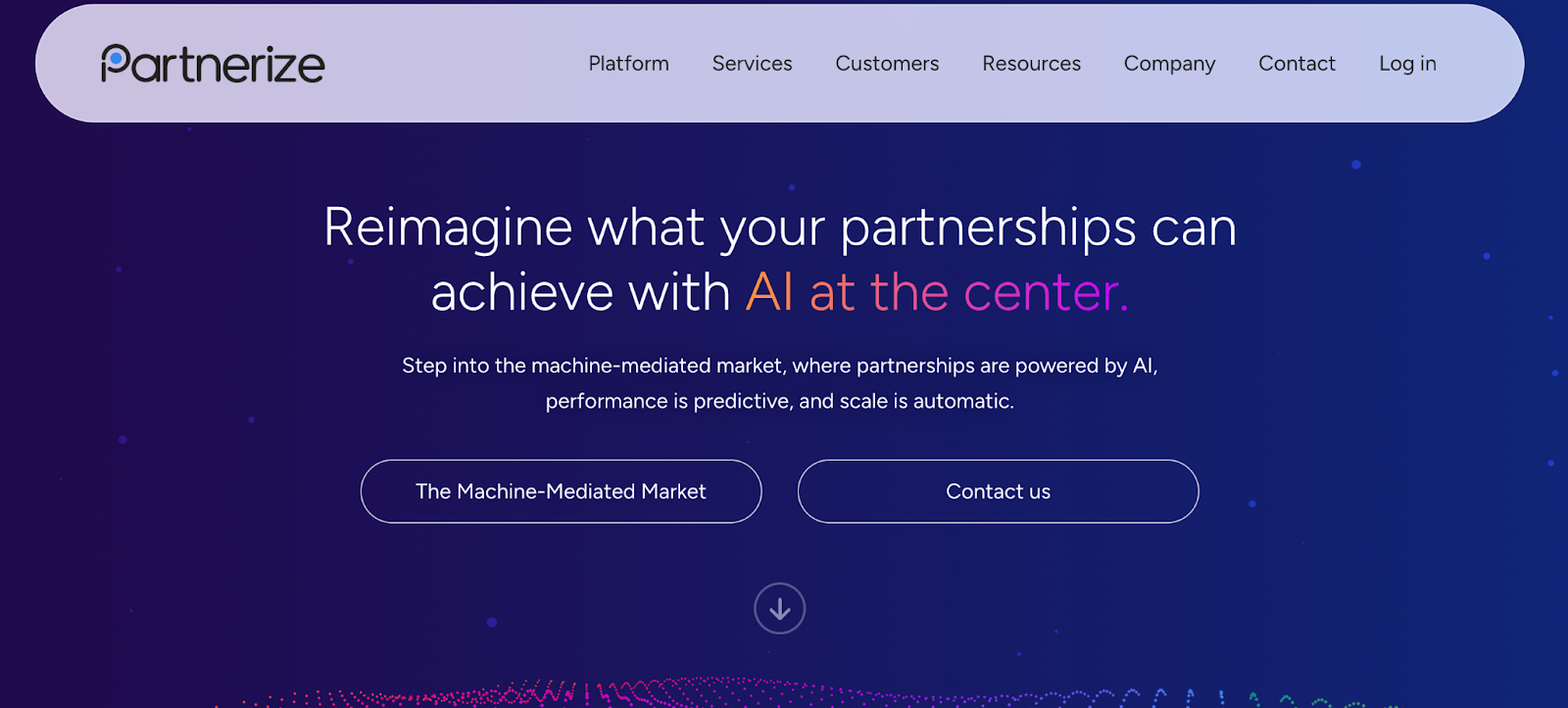
This one has an enterprise focus.
Partnerize provides a single platform for diverse partner types, making it particularly useful for those who manage both affiliate programs and broader partnership initiatives.
This platform supports a much wider range of partner types than Impact and provides robust optimization tools.
However, Partnerize does have a strong e-commerce and affiliate focus.
This means that if you’re looking for a B2B partnership solution, it’s vital to consider whether this platform caters best to your specific requirements.
Key capabilities:
- Contracting
- Payouts
- Advanced analytics features
11) TUNE
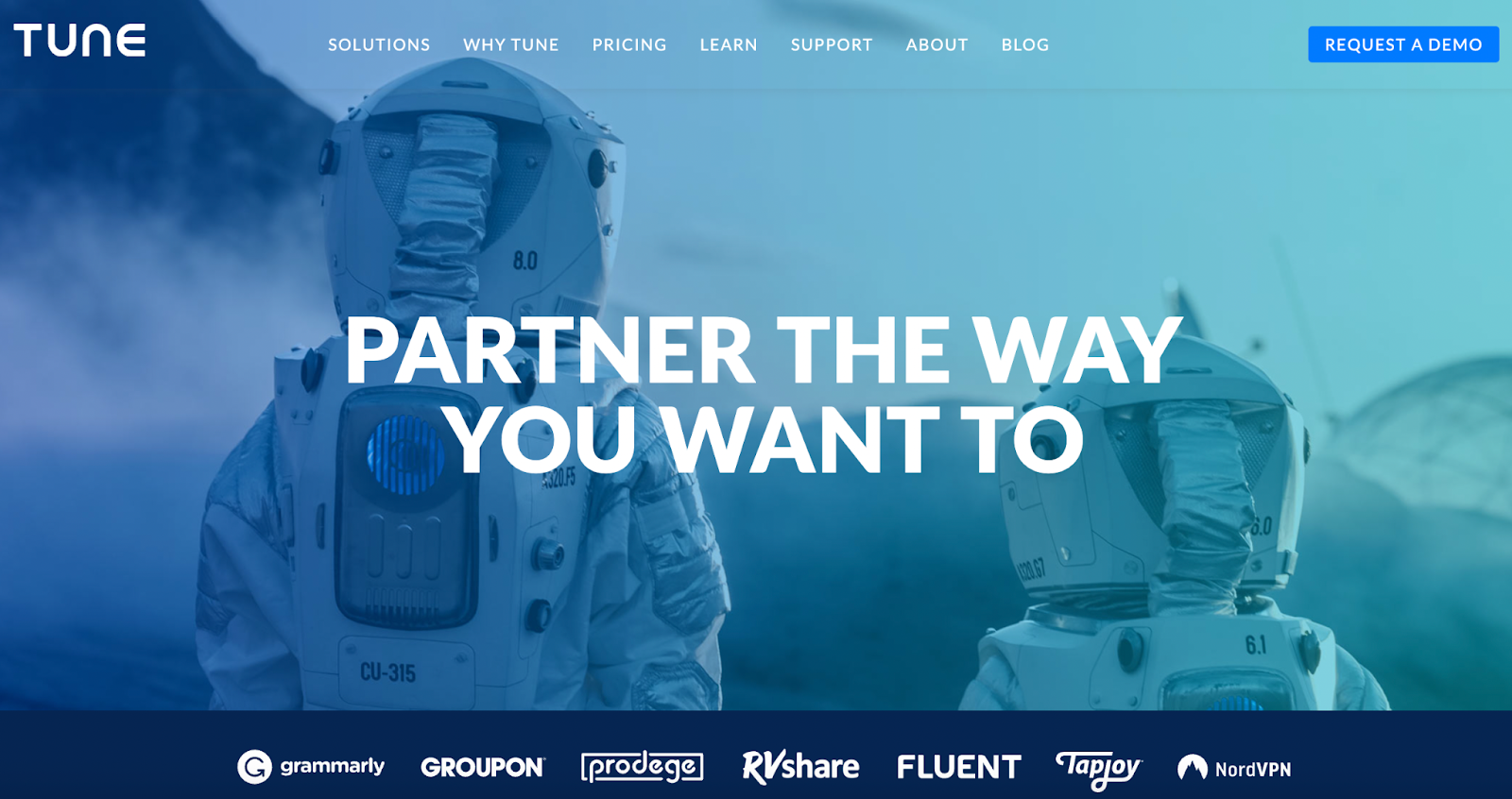
TUNE is designed for performance and affiliate marketing teams – especially those focused on mobile and app-based campaigns.
Businesses might pick this platform over Impact because of its flexible tracking capabilities and developer-friendly tools, which offer plenty of customization for technical integrations.
It’s important to note that TUNE is not built for B2B channel or co-sell programs.
This means while the platform might be useful for affiliate-focused retail brands aiming for ecommerce sales, it may not meet the needs of organizations looking to manage complex partner ecosystems beyond performance marketing channels.
Key capabilities:
- Custom tracking
- APIs
- Mobile SDKs
12) Affise
Built with affiliate networks and performance marketing in mind, Affise helps teams to streamline their operations and manage multiple affiliate performance programs efficiently.
While there’s overlap between Affise and Impact, Affise offers a more streamlined approach to affiliate operations and automated affiliate payouts.
Please note that Affise offers limited support for channel co-sell workflows, so it may not be suitable for organizations looking to manage broader B2B partner ecosystems.
Key capabilities:
- Tracking
- Fraud tools
- Program management
13) Everflow
Everflow is designed for performance and affiliate programs, especially those that demand comprehensive analytics and reporting capabilities from their partner marketing platform.
Indeed, this tech offers an alternative tracking stack to Impact, with flexible reporting and detailed analytics.
Keep in mind that Everflow is primarily affiliate-focused and offers limited support for CRM-native channel operations.
So think carefully about whether it’s suitable for complex B2B co-sell programs.
Key capabilities:
- Partner tracking
- Fraud prevention
- APIs
👉Discover some top Everflow alternatives here.
14) Salesforce PRM
Already work on Salesforce? Opting for Salesforce PRM could make your team’s life a lot easier.
Salesforce PRM is designed for teams that want their partner management fully integrated within their CRM – and it’s a very different solution to Impact.
Indeed, Salesforce PRM offers native Salesforce records, reporting, and extensibility, making it a strong choice for organizations that need a deeply integrated solution rather than an external affiliate-focused platform.
It’s worth noting that the out-of-the-box user experience is pretty basic, so the success of Salesforce PRM often depends on internal resources and technical assistance.
Or, in other words, how well you’re able to customize and optimize the system for your partner programs.
Key features:
- Partner accounts
- Deal reg
- Workflows
15) HubSpot + PRM Add-Ons
Looking for tailored solutions?
HubSpot-led go-to-market teams may decide to stick with their CRM and invest in some PRM add-ons.
By simply extending their CRM to manage partner programs, these teams can work with CRM-native performance data while selecting the partner extensions that best serve their purposes.
However, there are downsides to this approach.
Indeed, for organizations that need deeper PRM functionality, a dedicated PRM platform like Introw will be required.
HubSpot supports:
- Objects
- Workflows
- Partner tagging
- Reporting
Why SaaS Teams Pick Introw Over Impact
Introw is a very different solution to Impact, but if you’re looking for a PRM that supports SaaS partner management, it’s a powerful alternative.
Here’s why SaaS teams benefit from choosing Introw:
- Channel-first, not affiliate-first: Impact was designed for affiliate management and influencer programs, so its workflows revolve around clicks, payouts, and referral tracking. But Introw is purpose-built for SaaS, making deal registration, co-selling, and partner engagement its core focus.
- CRM-native: With Introw, all partner activity lives directly inside Salesforce or HubSpot, eliminating silos and giving you a single source of truth.
- Off-portal engagement: Many PRMs rely on portals that require logins. This adds friction to the partner journey and limits engagement. Introw meets partners where they work (such as email or Slack) for seamless collaboration.
- Automation everywhere: Eliminate tedious administrative tasks with Introw, and spend your time adding genuine value. Introw automates onboarding, campaign management, nudges, and even QBR prep.
- Attribution you can trust: Affiliate-first tools typically track clicks and last-touch referrals, which don’t accurately reflect the influence of SaaS partners. Introw ties content usage, notifications, and partner activity directly to pipeline and revenue for attribution you can feel confident in.
📣 Want to see Introw in action? Request a demo here.
Conclusion
Is it time to seek alternatives to Impact?
You’ll know when you’ve found the right Impact alternative for B2B SaaS, because it will improve co-selling, engagement, and attribution directly in your CRM.
When shopping around for Impact.com alternatives, take a step back to review how your current partner program works.
Consider whether your channel strategy is as effective as you’d like it to be, and identify any gaps.
Then:
1️⃣ Shortlist CRM-first PRMs
2️⃣ Run a live pilot
3️⃣ Choose the platform your partners actually respond to
👉 See how Introw can power your partner program – book a demo today.
Top 9 PartnerStack Alternatives to Consider in 2025
While partner platform PartnerStack works well for some businesses, it can fall short for SaaS teams needing deep CRM integration, a custom partner portal, and more reporting and automation capabilities.
If you're struggling with data silos, limited automation, or partner portals that don't work with your needs, it's time for a change.
Look for a solution built for RevOps, embedded in your CRM, and focused on revenue—not vanity metrics.
➡️ Explore why Introw is a top PartnerStack alternative — book your live demo today.
Why Look for a PartnerStack Alternative in 2025?
As the SaaS landscape evolves, businesses must continually re-evaluate their partnership management tools.
While PartnerStack remains a strong contender, shifting needs around customization, reporting, automation, and integration options may prompt some SaaS brands to explore alternatives that better align with their growth strategies and tech demands.
Is it time for your business to consider PartnerStack alternatives?
Read on to find out.
Where PartnerStack Falls Short for Scaling SaaS Teams
PartnerStack can help launch a partner program — but once you're driving real revenue through partners, it often hits its limits.
Here are three common friction points for SaaS companies trying to scale with PartnerStack:
1. CRM Disconnect
A lack of seamless integration with your CRM can lead to data silos, duplicated work, and missed opportunities for cross-team alignment.
In short — a headache.
After all, when your sales and partnership marketing platforms don't speak the same language, efficiency and visibility suffer.
Instead, look for partner management platforms that are fully embedded in your CRM.
2. No Off-Portal Collaboration
If your partners have to log into a portal just to stay in the loop, you're already creating friction. PartnerStack requires portal access for updates or engagement — which often leads to drop-off and delays.
There’s no support for off-portal collaboration, like replying to deal updates via email or Slack and having it sync back to your CRM. That disconnect slows down momentum and makes it harder to keep partners engaged.
Modern partner teams need tools that meet partners where they are — with frictionless, off-portal collaboration baked in.
3. No Customizable Portal Experience
As your partner program matures, a one-size-fits-all portal just doesn’t cut it. PartnerStack offers limited flexibility when it comes to customizing the partner experience — making it hard to support different partner types, tiers, or regional nuances.
If your team needs to tailor onboarding, branding, or workflows for referral partners vs. resellers vs. MSPs, PartnerStack likely falls short.
Look for platforms that offer fully customizable, white-labeled portals with CRM-driven logic — so every partner gets the right experience, at scale.
What to Look for Instead
If you've decided it's time to move on from PartnerStack, what should you be looking for from your partner management system?
1. CRM-Native with Real-Time Sync
In 2025, your partner platform must live inside Salesforce or HubSpot. That means native CRM integration — not just pushing spreadsheets into a dashboard. Real-time deal sync, automated registration, and shared pipeline visibility help you eliminate silos and keep everyone on the same page.
2. Frictionless Off-Portal Collaboration
Look for tools that make it easy for partners to engage without logging in — think Slack or email updates that sync directly to your CRM. Off-portal collaboration keeps momentum high and ensures reps and partners stay aligned in real time, not stuck chasing each other across platforms.
3. Custom-Branded, Flexible Partner Portal
Your partner portal should reflect how your business operates — not force you into a rigid template. Look for a PRM that lets you fully customize the portal layout, branding, and workflows to match your processes, partner model, and go-to-market motion. From content to deal reg flows, every part should feel like an extension of your company — not a bolt-on.
If PartnerStack is starting to slow your momentum — whether due to collaboration friction, limited CRM alignment, or lack of customization — it’s worth evaluating purpose-built tools designed for scale.
Let’s see…
Top PartnerStack Alternatives to Consider
When considering moving on from PartnerStack, it's essential to explore your options and identify the best fit for you.
1. Introw — Best CRM-Native PRM for SaaS Teams
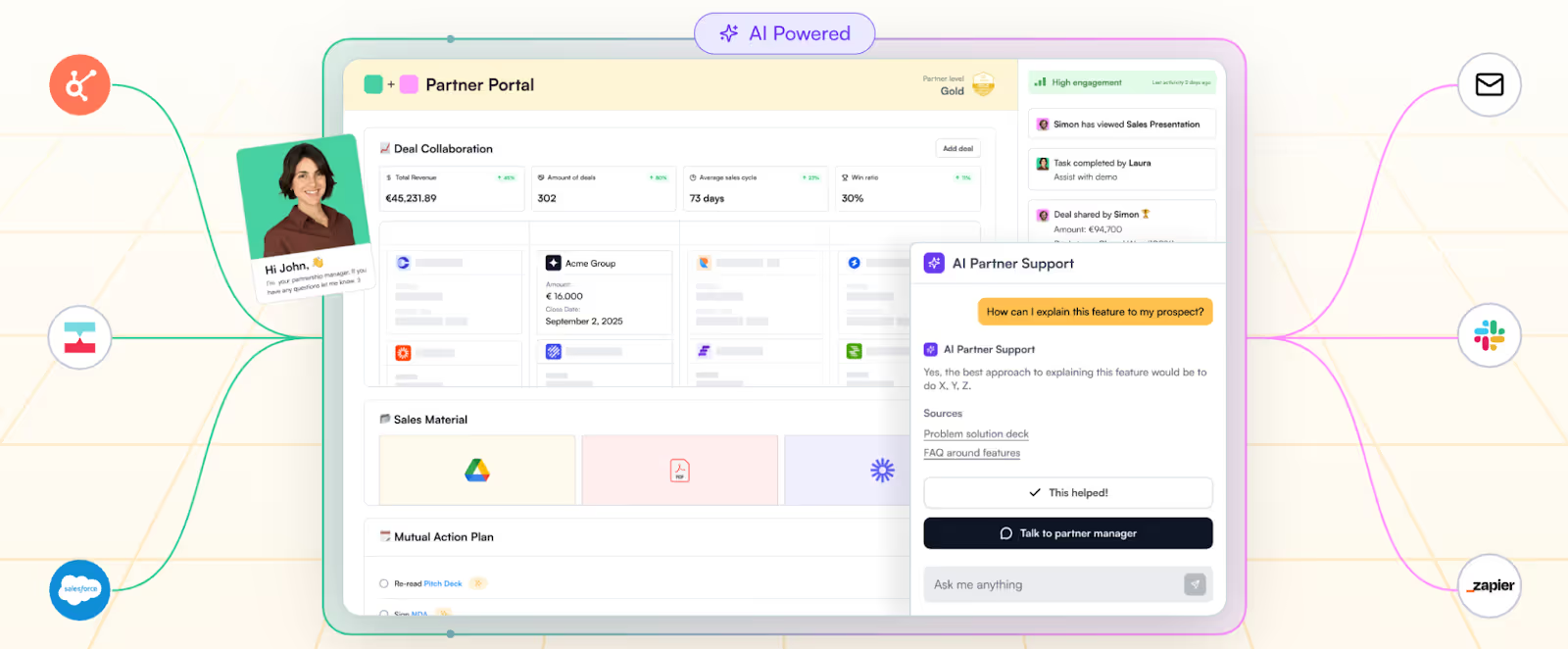
Introw is a sophisticated partnership relationship management (PRM) platform with deep Salesforce and HubSpot integrations.
Its CRM-first approach ensures that partnership data — such as leads, deals, engagement, and pipeline metrics — flows automatically between Introw and your CRM, keeping Salesforce or HubSpot as your single source of truth.
Other Introw highlights include:
- Real-time co-selling
- No-code partner portal builder
- AI Agent, providing 24/7 support to your partners
- No login needed for partners — off-portal experience
- Real-time deal reg, forecasting, and MAPs
- Modular workflows (referral, reseller, etc)
- Slack sync for nudges, updates
- Strong RevOps and CCO/CRO alignment
- Transparent pricing
Who Is Introw Best For?
Introw is perfect for SaaS teams with two or more partner managers and who already use (or intend to use) Salesforce or HubSpot.
Pricing: Introw is free for one partner. Its basic tier starts at $329 per month for ten partners, Pro costs $579+ per month for ten partners, and Enterprise pricing is bespoke. Book a live demo here.
2. Partnero
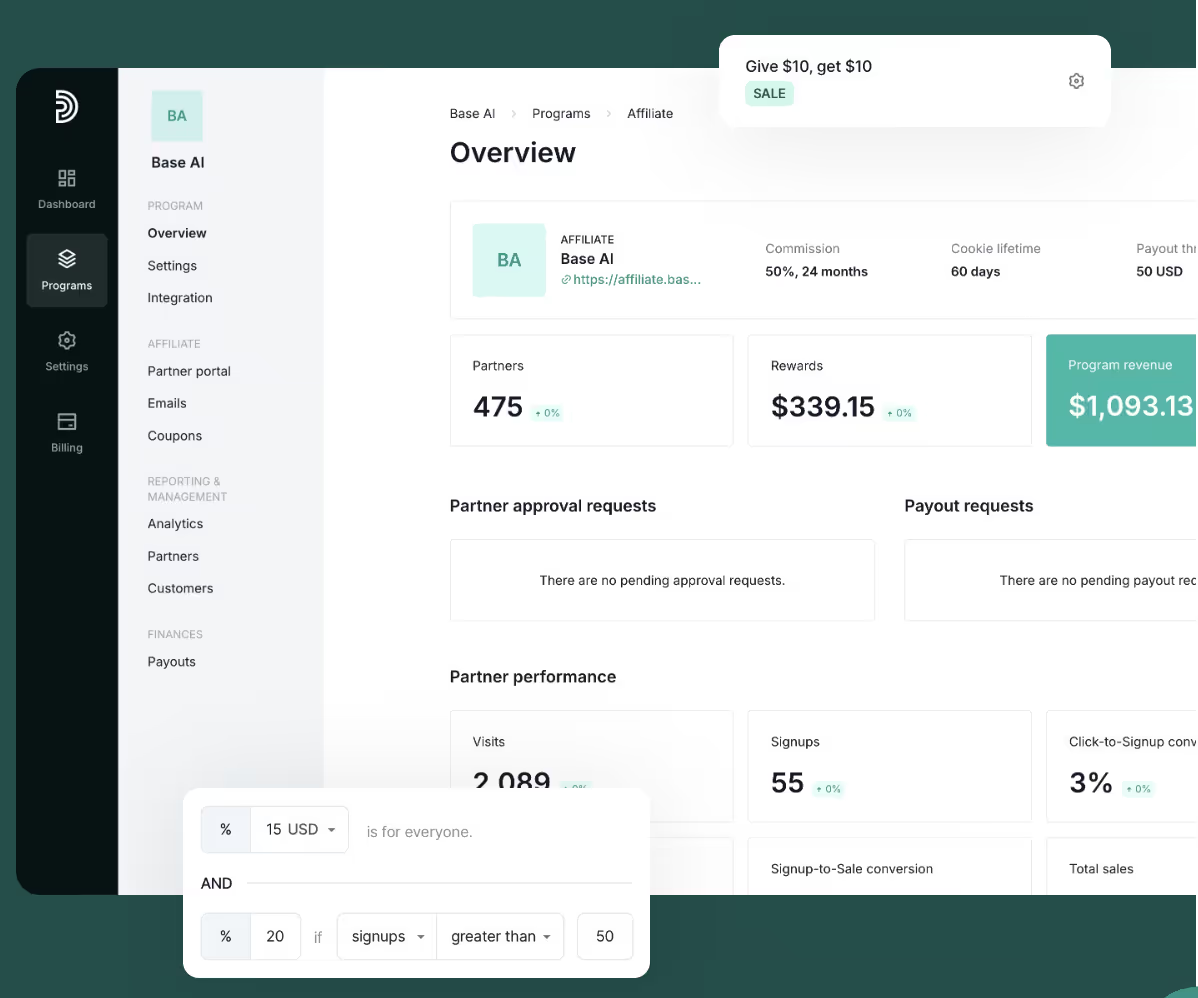
Partnero is an all-in-one partnership management platform designed for SaaS and e-commerce businesses to create, manage, and scale affiliate, referral, and newsletter referral programs.
Partnero supports automated payouts, offers fully customizable reward structures, white-label partner portals, and boasts seamless integrations with tools like Stripe, Shopify, PayPal, and WooCommerce.
Features include:
- All-in-one program management
- Customizable reward structures
- White-label partner portals
- Seamless integrations
- Automated payouts
- Real-time analytics
- Custom referral marketing links and coupons
- Partner enablement tools
- Developer-friendly API
Who Is Partnero Best For?
Partnero works best for companies running affiliate and influencer programs. Its lighter feature set works well for early-stage companies, but it's less ideal for scaling SaaS with mature CRMs.
Pricing: Partnero's starter bundle costs $49 per month, its Partner tier is $149 per month, and the Advanced option for larger companies comes in at $479 per month.
3. Kiflo
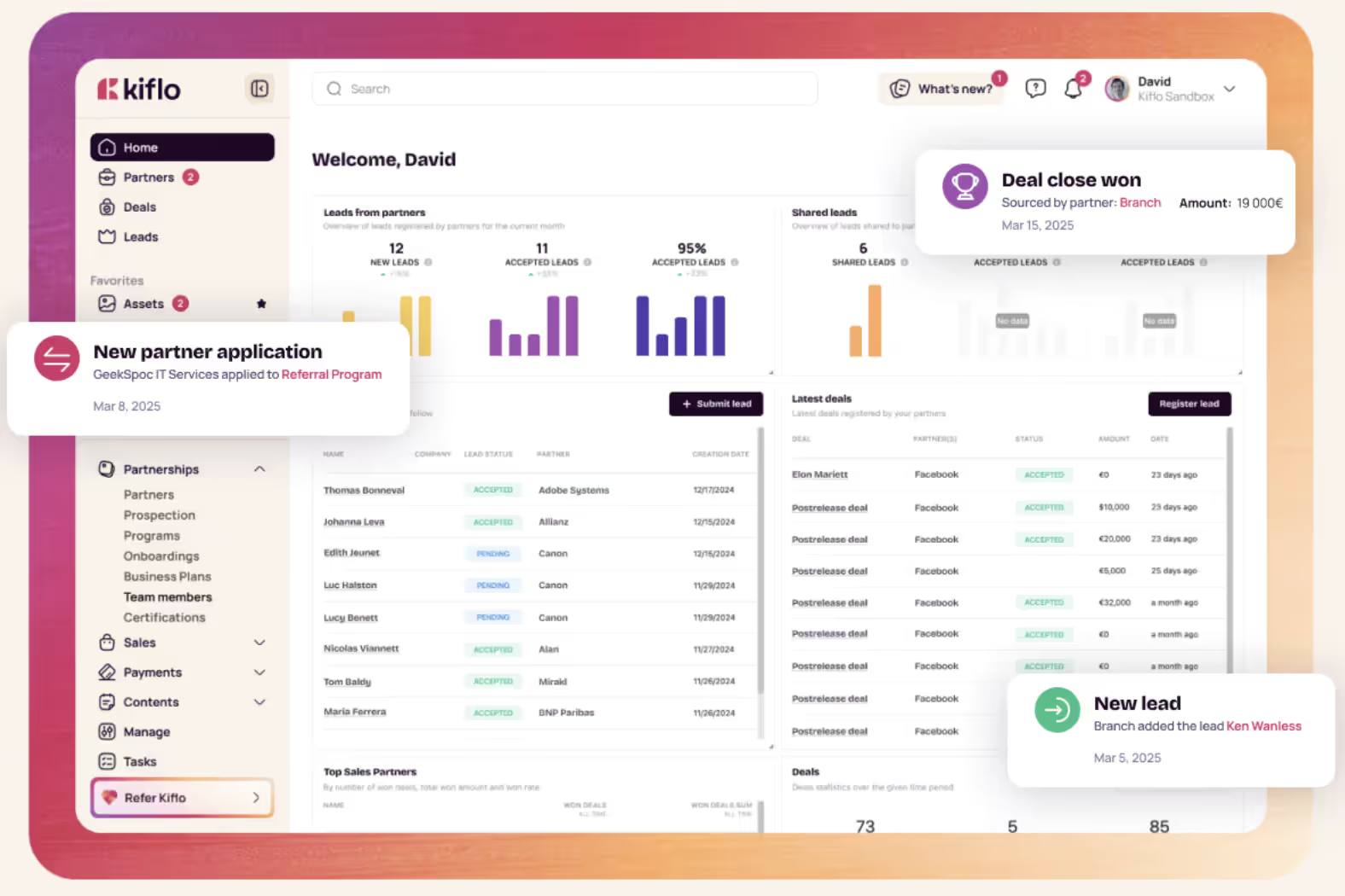
Kiflo is a PRM platform designed to help B2B companies grow and scale their partner programs.
It enables users to track partner-sourced revenue, manage leads, onboard and enable partners, and foster long-term, profitable partner relationships.
Specific features include:
- Partner onboarding and enablement
- Lead and deal management
- Revenue tracking and attribution
Who Is Kiflo Best For?
Kiflo is a great option for startups, with super easy onboarding.
However, it lacks a native Salesforce integration, so companies that rely on this CRM may want to consider alternatives.
Its analytics are also quite basic.
Pricing: Kiflo's Core tier — for teams just launching their partner program — starts at $359 per month. The Plus and Premier tiers operate on bespoke pricing plans.
4. Tolt
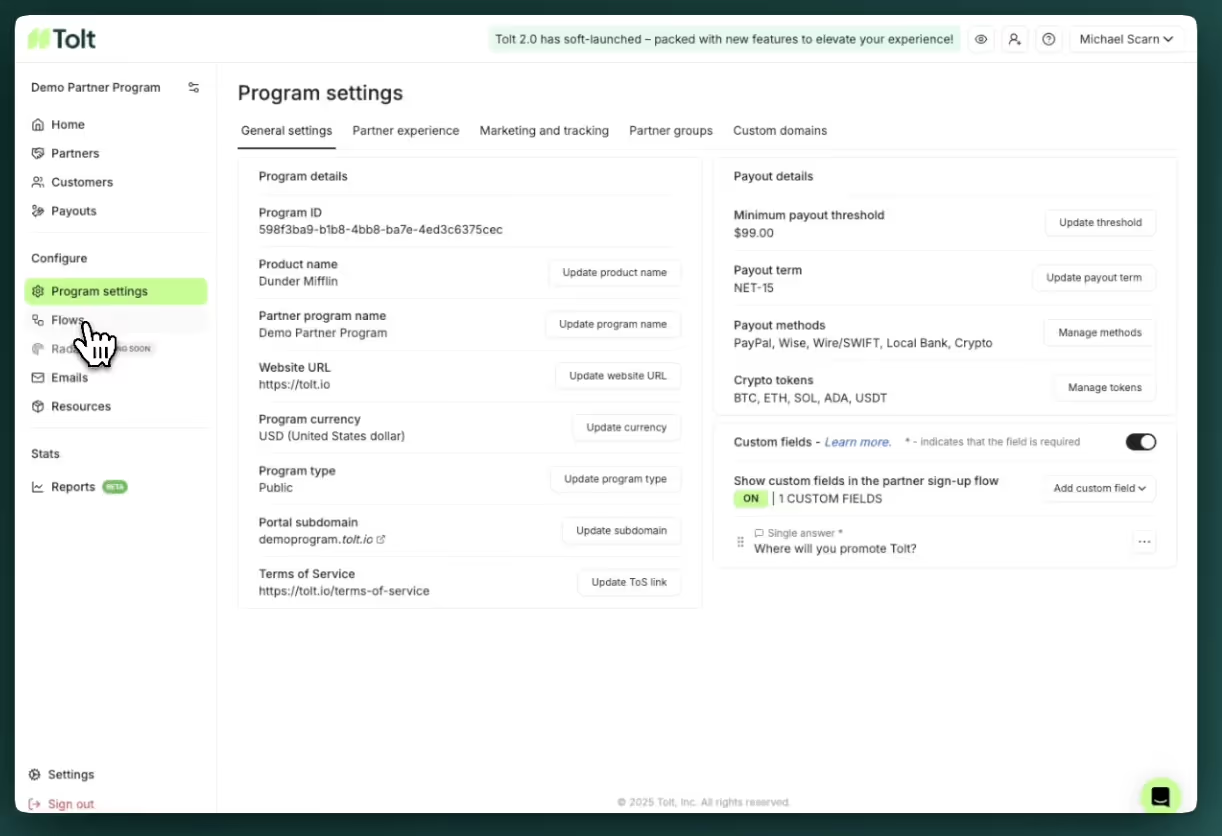
Tolt is an all-in-one affiliate marketing platform tailored for SaaS startups looking to swiftly launch and manage affiliate and referral programs.
With a heavy focus on partner onboarding, real-time analytics, and customizable commission structures, Tolt streamlines affiliate management, enabling startups to scale efficiently and cost-effectively.
Tolt's features include:
- Branded affiliate portals
- Real-time performance tracking
- Customizable commission structures
- Passwordless login for affiliates
- Quick setup within 15 minutes
Who Is Tolt Best For?
Tolt's focus is on partner onboarding, so it works well for companies that expect to attract a high number of new partners or simply want to impress their partners from the outset.
However, this tool is still maturing when it comes to deal registrations and pipeline management, and it doesn't natively support MAPs or Slack workflows — all of which make it a better option for startups and smaller businesses rather than mature partner programs.
Pricing: Tolt's Basic bundle starts at $49 per month, its Growth package is $99 per month, and the Pro option costs $199 per month.
5. Allbound
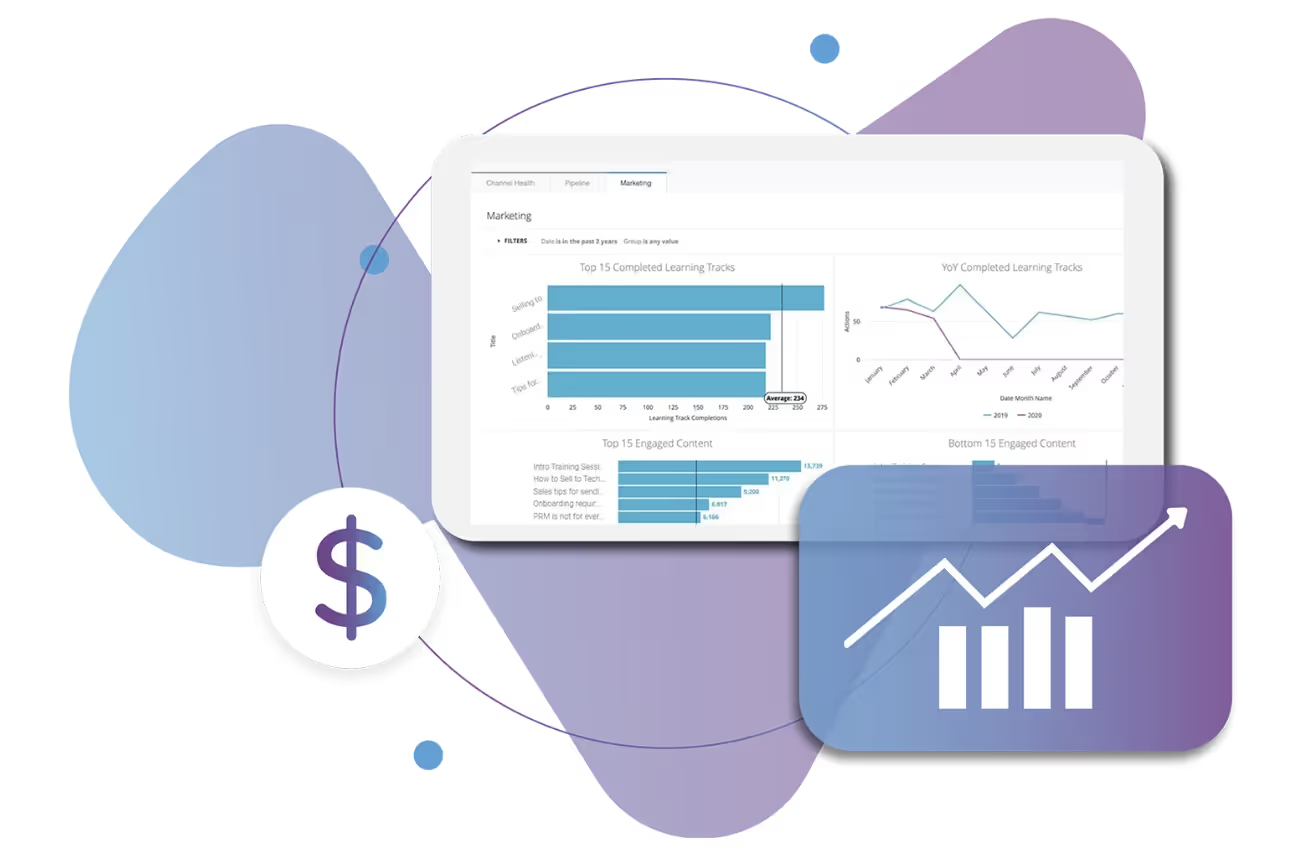
PRM Allbound is designed to streamline and automate every aspect of partner programs for B2B organizations.
It offers tools for onboarding, enablement, co-marketing, co-selling, and performance tracking, all within a unified interface.
Highlights include:
- Partner journey automation
- Content library and management
- Learning tracks and certifications
- Deal registration and playbooks
- Multi-tier distribution support
- Gamification and incentive dashboards
- Channel insights and reporting
- CRM integrations with real-time updates
Who Is Allbound Best For?
Allbound is a great option for mid-market to enterprise-level B2B tech businesses with mature or scaling partner ecosystems.
Pricing: Allbound's pricing is bespoke.
6. Impartner
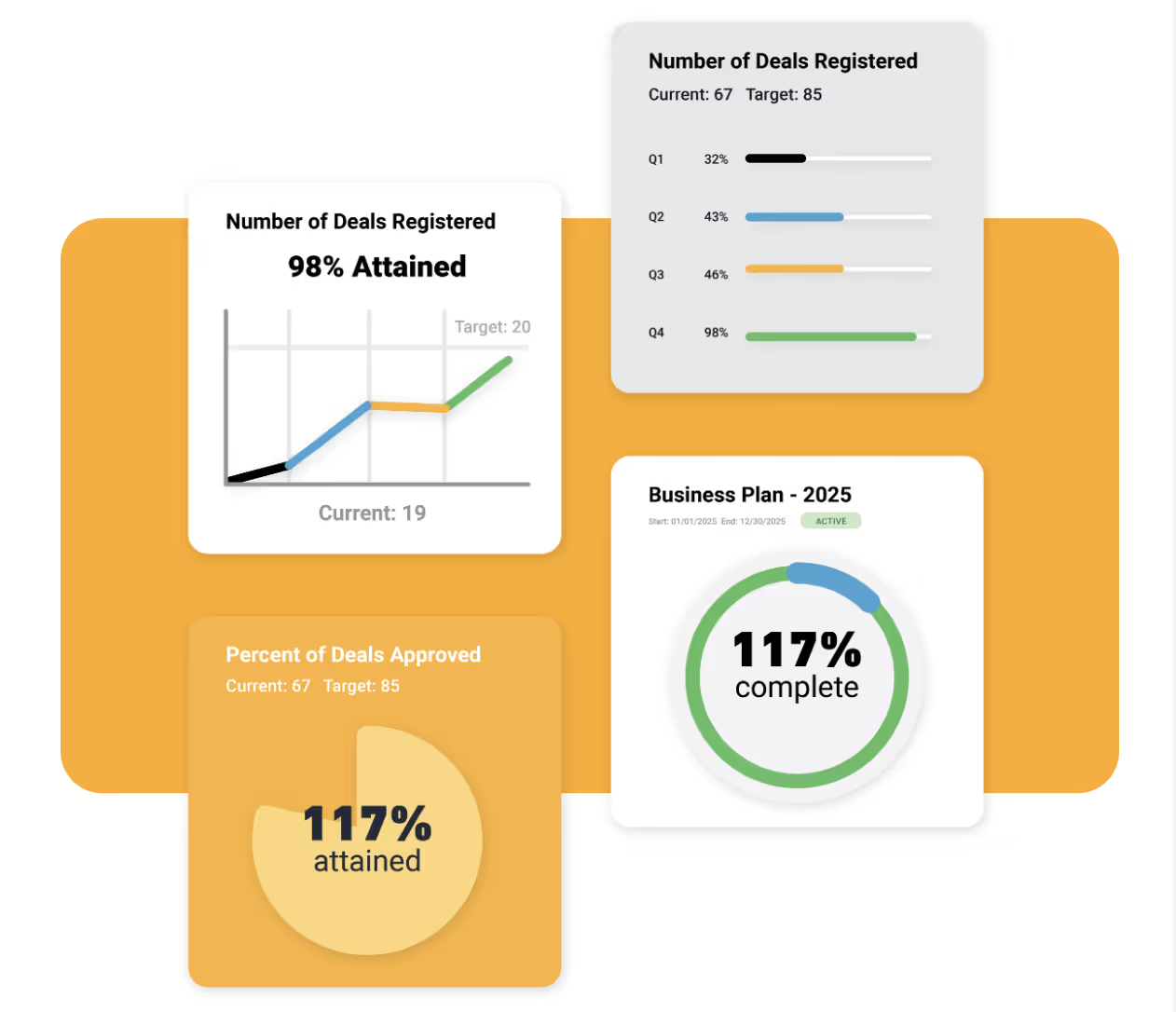
Comprehensive PRM platform Impartner is designed to help B2B companies manage and scale their partner ecosystems effectively.
It supports all types of partners, including reseller partners, distributors, affiliates, ISVs, and more.
Impartner offers comprehensive tools designed to help businesses enhance partner engagement, streamline operations, and drive revenue growth through indirect sales channels.
Highlights include:
- Automated partner onboarding and training
- Centralized partner portals with role-based access
- Deal registration and lead management
- Performance tracking and analytics dashboards
- Co-branded marketing asset creation
- Partner business planning and goal-setting
- Tiering and compliance automation
- CRM integrations with real-time data sync
- Referral and affiliate program support
Who Is Impartner Best For?
Impartner is a comprehensive PRM solution that works best for mid-sized to enterprise-level B2B companies with complex, global, or high-growth partner ecosystems.
Pricing: Impartner offers tailored pricing.
7. Impact.com
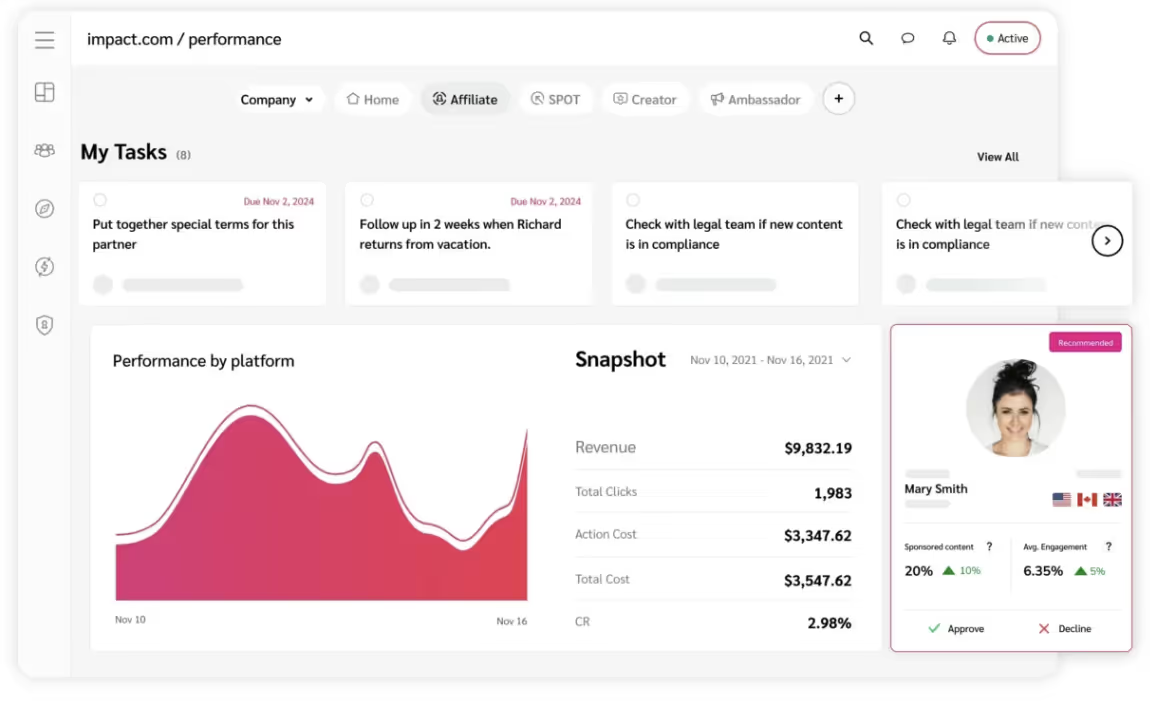
Impact.com is a comprehensive partnership management platform that enables businesses to manage and optimize various types of partnerships — including affiliates, influencers, creators, B2B partners, and referrals — within a single system.
Its features include:
- Partner discovery and recruitment automation
- Automated payments and contracts
- Real-time tracking and performance analytics
- Fraud detection and prevention
- Customizable attribution modeling
- CRM and e-commerce platform integrations
- Role-based access and permissions
- Automated partner onboarding workflows
- Benchmarking reports against industry peers
Who Is Impact.com Best For?
Impact.com is best for companies that want to build, manage, and scale diverse, performance-based partnerships in a unified platform.
It's particularly well-suited for large companies, e-commerce and DTC brands, and agencies and networks that are running partnership programs for multiple clients.
Pricing: Impact pricing is bespoke.
8. Rewardful
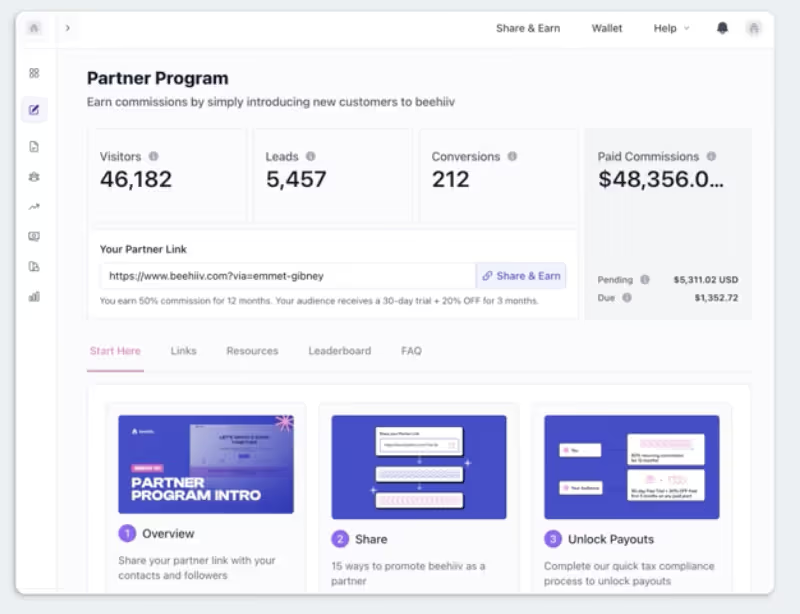
Rewardful is an all-in-one affiliate and referral management platform tailored for SaaS companies and subscription-based businesses.
It enables users to launch affiliate programs in under 15 minutes through seamless integrations with Stripe and Paddle.
Here are its top features:
- Easy Stripe and Paddle integrations
- Customizable commission structures
- User-friendly affiliate portal with branded customization
- Automated payouts via PayPal and Wise
- Real-time tracking of referrals and conversions
- Coupon code and link-based referral partners tracking
- Fraud detection and prevention mechanisms
- Affiliate finder tool
- White-label capabilities
- Analytics dashboard
Who Is Rewardful Best For?
Rewardful is best for bootstrapped to mid-sized SaaS companies that use Stripe or Paddle for billing and want fast, no-code affiliate setup.
It's also great for subscription businesses that need recurring or one-time commission models.
Pricing: Rewardful's Starter package costs $49 per month, and its Growth bundle is $99 per month, while Enterprise pricing starts at $149 per month.
9. Partnerize
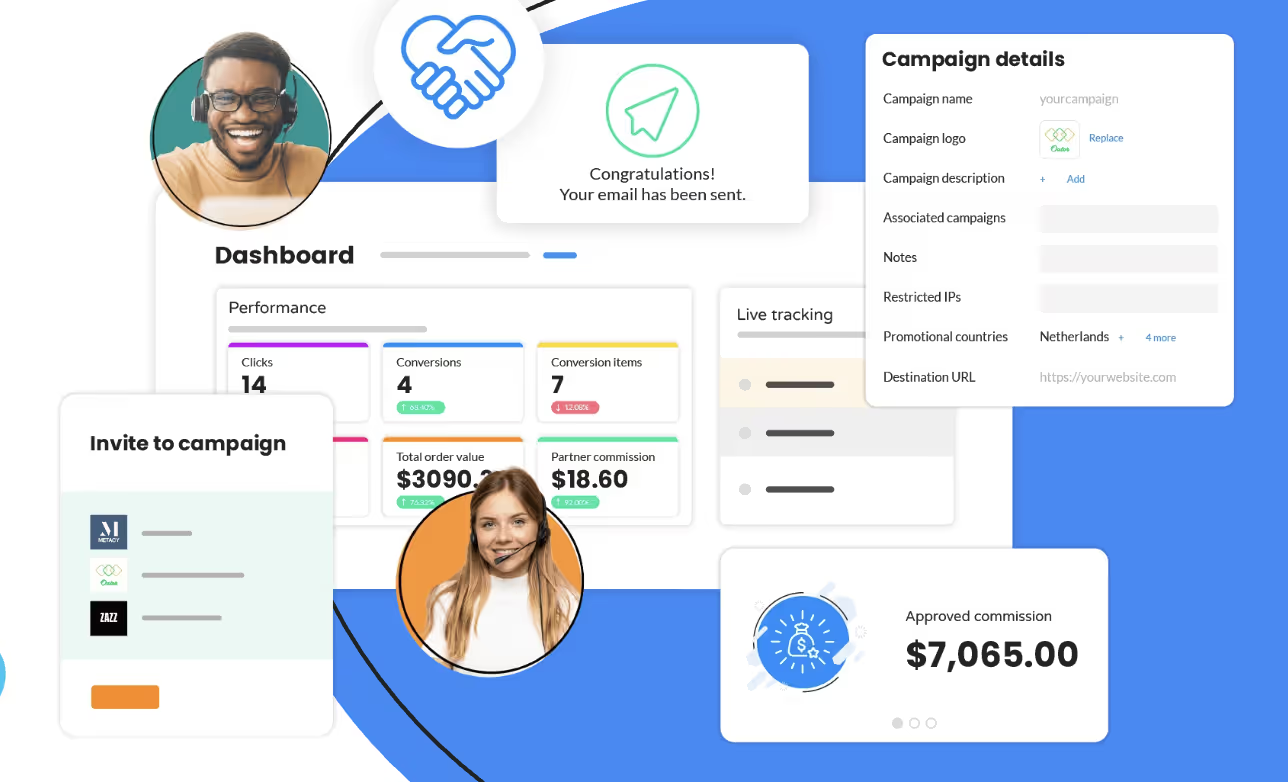
Partnerize is a comprehensive end-to-end partnership management platform designed to help brands discover, manage, and optimize diverse partner relationships at scale.
It supports various partner types, including affiliates, influencers, and content creators.
Its key features are as follows:
- Automated partner discovery and recruitment
- Dynamic commissioning based on performance metrics
- Real-time tracking and analytics dashboards
- Brand safety and fraud prevention tools
- Customizable reporting and attribution models
- Integration with major e-commerce and CRM platforms
- Role-based access controls and user permissions
- Dedicated partner portals
Who Is Partnerize Best For?
Partnerize is ideal for mid-sized to enterprise-level businesses seeking to scale their partnership programs efficiently.
It's especially beneficial for companies that manage a diverse range of partners and/or operate in multiple regions.
Pricing: Fees vary depending on your requirements.
How to Choose the Right PartnerStack Alternative
Ready to find the very best partner management platform for your business?
Here are three major points to consider.
1. Prioritize CRM Compatibility
It's vital that your PRM integrates seamlessly with your CRM — such as Salesforce or HubSpot.
A partner management platform that doesn't sync in real time can create data silos, duplicate efforts, and missed opportunities.
So, look for a solution that supports native, two-way CRM integration to ensure accurate reporting, streamlined workflows, and a single source of truth.
2. Focus on Channel Revenue, Not Just Signups
It's easy to get caught up in growing partner signups — but quantity doesn't equal quality.
The right PRM should help you measure what really matters: channel revenue.
Prioritize tools that track partner-sourced and influenced deals, connect activity to pipeline stages, and surface performance metrics.
3. Evaluate User Experience for Partners
A great partner experience drives engagement and results.
If your PRM requires complex logins or clunky portals, partners simply won't use it.
It's crucial to find tools that offer frictionless interaction — like replying to deal threads via email or Slack without logging in.
The right platform should also provide visibility into partner activity (opens, clicks, replies), allowing you to track engagement and follow up effectively without requiring constant manual check-ins.
Why Introw Leads the Pack in 2025
Introw stands out as the leading PartnerStack alternative by delivering a modern, revenue-focused approach to partner management with deep CRM integration.
This user-friendly PRM platform delivers a fully embedded experience in platforms like Salesforce and HubSpot and offers real-time co-selling capabilities, keeping your partners and pipeline in sync.
Meanwhile, its no-code portal builder enables tailored partner experiences, and its Slack and email integration makes communication easy, while a built-in AI Agent offers 24/7 support.
Purpose-built for SaaS, RevOps, and scale, Introw prioritizes actual revenue over vanity metrics.
➡️ Ready to experience the future of partner management? Request a live Introw demo here.
Partner Analytics - Metrics & Tools to Measure Partnership Channel ROI
Get your SaaS channel partnerships right, and they should drive a significant portion of your revenue and growth.
But to enjoy strong results from partner programs, SaaS leaders must first understand how they are performing and why.
This is where partner analytics comes in.
After all, without clear visibility, leaders risk missed opportunities, inefficiencies, and poor ROI.
Invest in partner analytics, and you’ll be empowered to make better decisions, develop stronger relationships, and enjoy more scalable, predictable partner-led growth.
In this guide, we’ll take you through the core partner analytics that SaaS businesses should be tracking, explain how to operationalize these metrics, and cover the top tools — like Introw — that power these processes.
📈 Introw makes partner analytics easy, empowering you to make the data-driven decisions necessary to take your program to the next level. Book a demo here.
What Is Partner Analytics?
Operating a strong partner analytics scheme is crucial for partnership success.
But what exactly do we mean by ‘partner analytics’, and why is it so important for SaaS brands?
Defining the Term
‘Partner analytics’ refers to tracking and analyzing data on how channel, referral, or strategic partners contribute to revenue, sales pipeline, and customer acquisition.
This means tracking key metrics that show progress towards your partner-related goals, and using these insights to regularly make data-driven decisions designed to optimize your partnership program.
While this may sound time-consuming (and once upon a time it was), in 2025, there are plenty of partner analytics tools on the market that make tracking and analysis quick and easy.
And it’s worth investing in these tools — in the fiercely competitive SaaS landscape of 2025, partner ecosystems are increasingly becoming a key revenue stream for brands.
This means that understanding partner performance is more important now than ever before.
Indeed, with tighter budgets, rising growth targets and more competition, SaaS leaders need precise insights to prioritize high-performing partnerships and scale efficiently.
Why It’s Mission-Critical for SaaS Growth
As partner ecosystems become a core segment of SaaS go-to-market strategy, partner analytics is mission-critical for SaaS growth.
Here’s why.
Firstly, chief revenue officers (CROs) and chief customer officers (CCOs) rely on having a forecastable pipeline to plan and hit growth targets.
Without clear partner data, this vital visibility breaks down.
Meanwhile, RevOps teams demand clean, clearly-attributed data to accurately report on performance and optimize processes across channels.
And channel managers must prove the impact of their partners to secure budget and resources.
This is impossible without real-time insights.
Partner analytics addresses these needs simultaneously, enabling teams to track sourced and influenced revenue, identify top-performing partners, and make confident, data-driven decisions.
Ultimately, in a highly competitive SaaS landscape where efficiency and accountability are key, measuring and managing partner performance isn’t just helpful — it’s essential for driving sustainable, scalable growth.
Core Partner Analytics Metrics to Track
So, we’ve established that tapping into partner analytics is essential for SaaS success, and we know why it’s so important.
But how can you effectively harness the power of partner analytics?
Here are six types of core partner analytics metrics to track.
1. Partner-Sourced Revenue
The most important metric when it comes to tracking third party performance, this quantifies the total revenue generated directly through leads, opportunities, or deals sourced by external partners.
To make this metric actionable, break it down into components like:
- Total Revenue
- Number of Partner-Sourced Deals
- Average Deal Size
- Sales Cycle Length
- ARR (Annual Recurring Revenue) and MRR (Monthly Recurring Revenue)
Analyzing these dimensions by partner, deal stage, or deal type can reveal what’s working and where to optimize.
CRM alignment is critical. When your PRM integrates natively with your CRM (like Introw does with HubSpot and Salesforce), these metrics are automatically tracked — no need for disconnected spreadsheets or manual exports.
Instead, you get real-time, reliable insights directly inside your CRM, improving forecasting accuracy, boosting efficiency, and making strategic decisions easier and faster.
2. Partner-Influenced Revenue
Not every deal starts with a partner — but that doesn’t mean they don’t play a critical role. Partner-influenced revenue captures the deals where your direct sales team owns the motion, but a partner steps in to support, accelerate, or strengthen the outcome.
There are a few common scenarios where looping in a partner makes sense:
- Integration Partners: let’s say your prospect mentions they use a platform you integrate with. Inviting that partner’s CSM or account manager into the deal can build trust, reduce perceived risk, and help speed up the close.
- Reseller or Regional Partners: maybe you’re selling into a region like Australia, but don’t have local coverage. A trusted reseller can step in to help with sales execution and post-sale support — making the deal more likely to land.
While these deals aren’t “sourced” by partners, the partner’s involvement clearly adds value. The challenge is attribution: how do you track and measure that influence?
That’s where having CRM-native attribution models comes in. When you tag partner involvement — at the contact, opportunity, or activity level — you start to get real visibility into which partners are actually driving results. And over time, this data becomes a key part of understanding partner ROI, optimizing enablement, and scaling what works.
3. Deal Registration Metrics

Deal Registration Metrics track partner-submitted sales opportunities, measuring volume, approval rates, conversion rates, deal velocity, win rates and average deal size.
These metrics help SaaS leaders evaluate partner engagement, pipeline quality, and program effectiveness, revealing how effectively partners contribute to revenue growth through registered deals.
Introw automatically syncs partner data through its integrations with CRMs like Salesforce and HubSpot.
It detects partner accounts, imports contacts, and maps deal registrations in real time, keeping your CRM as the single source of truth.
The result?
Seamless collaboration and accurate tracking of partner-sourced revenue.
4. Engagement Analytics
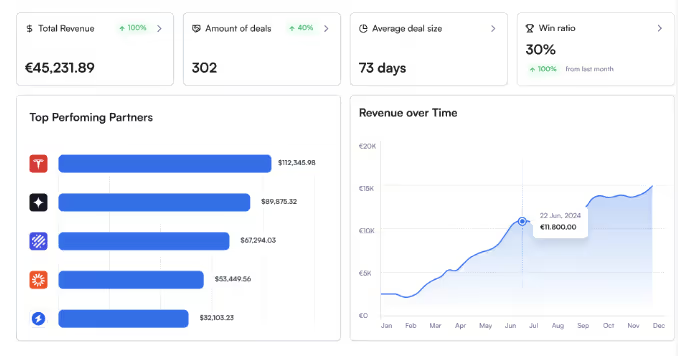
Your engagement analytics measure how actively partners interact with your communication and enablement channels.
Put simply, high engagement means better partner performance and deal outcomes.
Key indicators include email opens, showing interest in campaigns or updates; Slack replies, reflecting real-time collaboration and responsiveness; and portal views, indicating how frequently partners access resources or training materials.
These metrics help channel managers gauge partner interest, identify engaged versus disengaged partners, and optimize communication strategies.
Tracking these interactions enables more personalized support, targeted enablement, and data-driven decisions to improve overall partner program effectiveness and return on investment (ROI).
5. Pipeline Contribution & Forecasting Accuracy
Want to assess how much revenue partners generate and how reliably their deals close?
This is where pipeline contribution and forecasting accuracy come in.
Tracking your partners’ contribution to your pipeline helps identify high-performing partners and predict future revenue.
It gives you oversight of their pipeline-related activities, such as sourcing leads, registering deals, and co-selling opportunities.
Accurate forecasting is a huge advantage for SaaS brands.
To optimize your forecasting, you must first track accuracy using forecasting dashboards inside Salesforce or HubSpot.
6. Partner Health & Activity Score
This metric measures partner engagement and effectiveness based on key interactions and performance.
For example, you may wish to track touchpoints like meetings or communications, shared content such as training or enablement materials accessed, and recent deals registered or closed.
In 2025, this doesn’t have to be consuming, with partnership trackers doing the hard work for you.
Your partner health and activity score helps to identify active, high-potential partners versus inactive ones.
This enables channel teams to prioritize support, optimize enablement, and drive stronger pipeline contribution through more engaged partnerships.
How to Operationalize These Metrics
Once you’ve chosen the most relevant metrics for your partner program, how can you implement them?
Here are three vital tips for actioning your partner metrics.
Use Your CRM as the Source of Truth
Stop managing your partner analytics in spreadsheets, and instead use your CRM as your single source of truth.
Benefits of this approach include:
- Real-time, centralized data
- Better data integrity and more accurate data
- Improved scalability
- Better security
- Automated reporting
- Partner trust and transparency
To ensure your CRM is your single source of truth, it’s vital to invest in a PRM that plugs into your CRM (Introw, for example, integrates with Salesforce and HubSpot).
Set Up Alerts and Triggers for Partner Teams
Leverage Introw’s workflow automation features to set up alerts and triggers for your partner teams in your CRM.
This setup allows you to define specific events that automatically trigger notifications, such as a partner registering a lead, a deal reaching a new stage, or a task being assigned.
These notifications can be sent via Slack or email, ensuring real-time communication with your partners.
This approach keeps partners informed and engaged without requiring them to log into a portal, facilitating off-portal collaboration and timely updates.
Build Scorecards for Executive Stakeholders
Creating scorecards for executive stakeholders helps to align your partner program with your business goals — and achieving this is essential for success.
You can use dashboards to clearly show the impact of partners on pipeline and revenue, which is crucial for engaging CROs and driving continued investment.
With this in mind, scorecards should highlight KPIs like partner-sourced revenue, win rates, and deal velocity.
Include mutual action plans to show progress on shared goals and timelines, and incorporate automated reporting to keep leadership informed in real time.
This data-driven approach builds credibility, helps prioritize strategic partnerships, and ensures the partner program is seen as a measurable growth driver — not just a support function.
Tools That Power Channel Partner Analytics
In 2025, plenty of tools can significantly boost your partner analytics efforts.
Excellent partner relationship management (PRM) software like Introw is vital for success.
Not only does it improve forecasting, performance tracking, efficiency and partner relationships, but it centralizes your collaboration and automates tedious, time-consuming tasks.
What to Look For in a Partner Analytics Tool
- Native CRM integration: Ensures seamless, real-time syncing of partner data with your CRM platform, such as Salesforce, HubSpot, reducing data silos and improving accuracy.
- No manual data mapping: Automatically recognizes and aligns partner fields and objects without requiring a tedious setup.
- Custom workflows per partner type: Allows you to tailor processes, alerts, and reporting based on partner tiers.
Why Introw PRM Stands Out
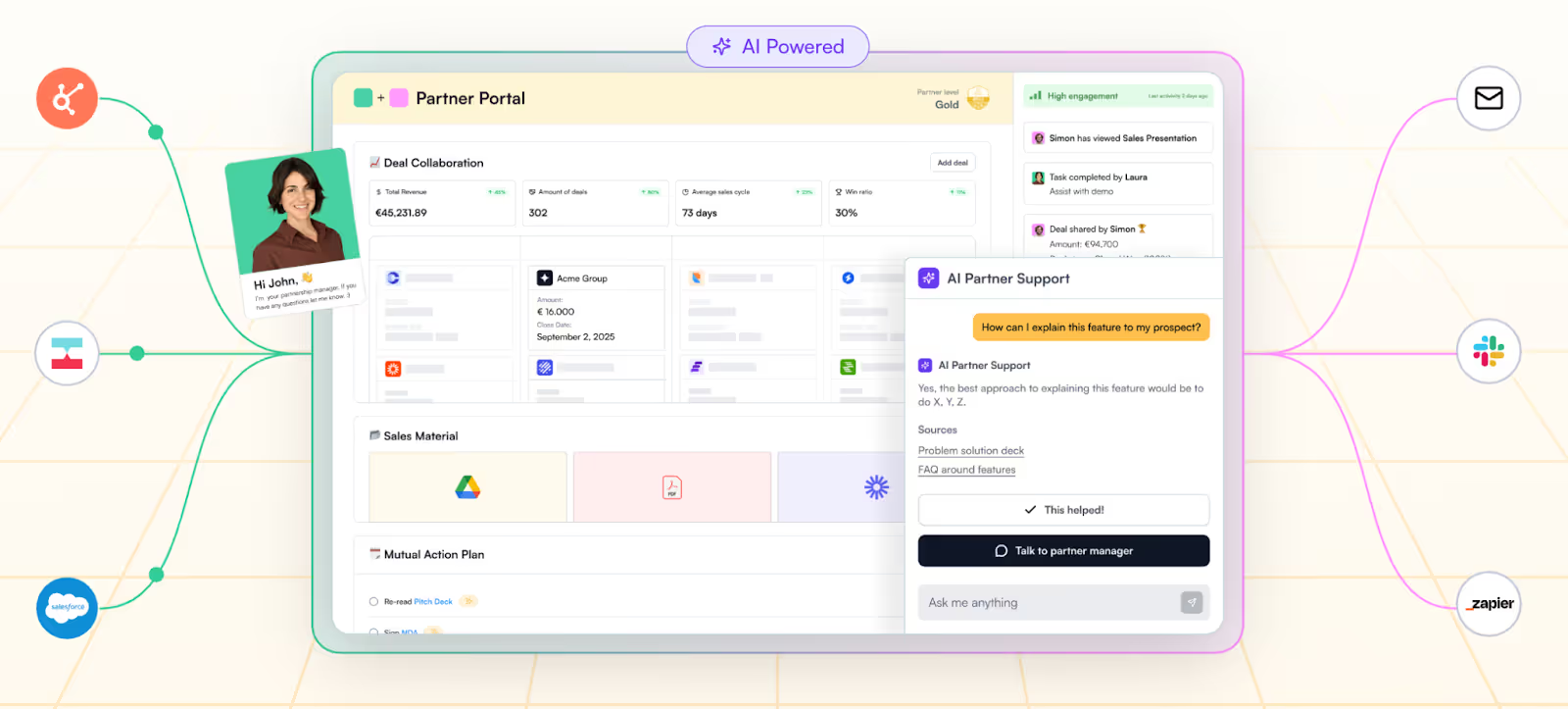
Here’s why you should consider investing in Introw PRM.
- A powerful analytics engine built into your CRM. Introw seamlessly integrates with your existing CRM, such as Salesforce or HubSpot, embedding partner analytics directly within your primary sales platform to eliminate data silos.
- Track deal flow, engagement and revenue — no external tools needed. With Introw, you can monitor partner deal registrations, engagement metrics, and revenue contributions in real-time, all within your CRM, removing the need for separate tracking tools.
- Fully white-labeled scorecards enabling partner performance insights. Introw provides customizable, white-labeled partner scorecards that offer real-time insights into partner performance, enabling you to evaluate and prioritize partnerships effectively.
➡️ Find out more about Introw’s partner portal or request a demo here
Summary: From Insight to Impact
In 2025, tracking partner analytics is non-negotiable.
After all, partner ecosystems are driving a growing share of SaaS revenue.
Without clear data on deal flow, engagement, and ROI, companies risk underperforming partnerships, misallocated resources, and missed growth.
Partner analytics empower smarter decisions, stronger collaboration, and measurable impact in today’s ecosystem-led go-to-market strategies.
To recap, the six key metrics every SaaS team should monitor are:
- Partner-sourced revenue
- Partner-influenced revenue
- Deal registration metrics
- Engagement analytics
- Pipeline contribution and forecasting accuracy
- Partner health and activity score
✅ Is it time to audit your current partner analytics system? Explore how Introw could level up your partnerships by booking a demo here today.
How to Build a Channel Partner Program Guide 2025: Step-by-Step Instructions
SaaS brands are increasingly learning on channel partner programs to tap into new markets and accelerate growth without increasing sales team overhead. Within modern channel partner programs, companies collaborate with third parties, such as resellers or service providers, to market and sell their products. These ecosystems are a perfect fit for SaaS brands that are already using HubSpot or Salesforce. In this step-by-step guide, you'll learn whether a partner program is a good fit for you and how to build one from beginning to end.
Why Channel Partner Programs Matter in 2025
Channel programs have been around, in one form or another, for years.
After all, businesses have always recognized the benefits of having diverse revenue streams.
But it's only recently that these partnerships have been worked into formal strategies.
This is partially because we now have tech — such as partner relationship management systems (PRMs) — that allow us to easily manage and scale partner ecosystems.
But it's also because, in 2025, we need strategic partner programs more than ever.
Here's why.
The Shift to Ecosystem-Led Growth
Channel partners extend market reach, accelerate customer acquisition, and slash sales costs.
And in 2025, these benefits are extremely valuable.
After all, it's not easy out there — SaaS brands are now contending with intense market saturation, rising customer acquisition costs and longer sales cycles.
However, with the right go-to-market (GTM) strategy, there are huge opportunities in SaaS.
Indeed, partners help SaaS companies penetrate new regions and verticals more effectively, thanks to their established customer relationships and local market knowledge. Also, Partner Deals have a 32% bigger deal size and 2.8X higher win rate.
Companies with partner programs are also up to 5x more likely to exceed expectations on a variety of business metrics.
Partners provide value-added services like integration, customization, and support, enhancing customer satisfaction and retention.
As SaaS buyers increasingly seek solutions tailored to their specific needs, trusted channel partners act as advisors, boosting credibility and trust.
Additionally, leveraging partner networks enables SaaS providers to scale rapidly without significantly expanding internal sales teams, making GTM efforts more agile and cost-efficient.
Key Benefits for SaaS Companies
To recap, the four key benefits of ecosystem-led growth for SaaS companies are as follows:
- Scalable revenue: Partner ecosystems enable SaaS companies to grow revenue without a proportional increase in headcount or operational costs, creating a more efficient path to scale.
- Market reach: Partners provide access to new regions, industries, and customer segments that would be costly or time-consuming to penetrate directly.
- CAC reduction: By leveraging partners' existing customer relationships and brand trust, SaaS companies can significantly lower their CAC.
- Shorter sales cycles: Trusted partners can accelerate deals by guiding prospects through the sales process, reducing friction and time-to-close.
Are You Ready to Build One?
As outlined above, strong partnership programs have myriad benefits for SaaS brands.
However, not every company is in the right place to start building its program.
In order for your scheme to drive success, first you need to build the right foundations.
Is your company ready to start building your partnership scheme?
⬇️ If you answer 'yes' to the three questions below, you've got the green light!
- Do you have 2+ partner managers?
- Are you already using either Salesforce or HubSpot?
- Do you already have some partner traction?
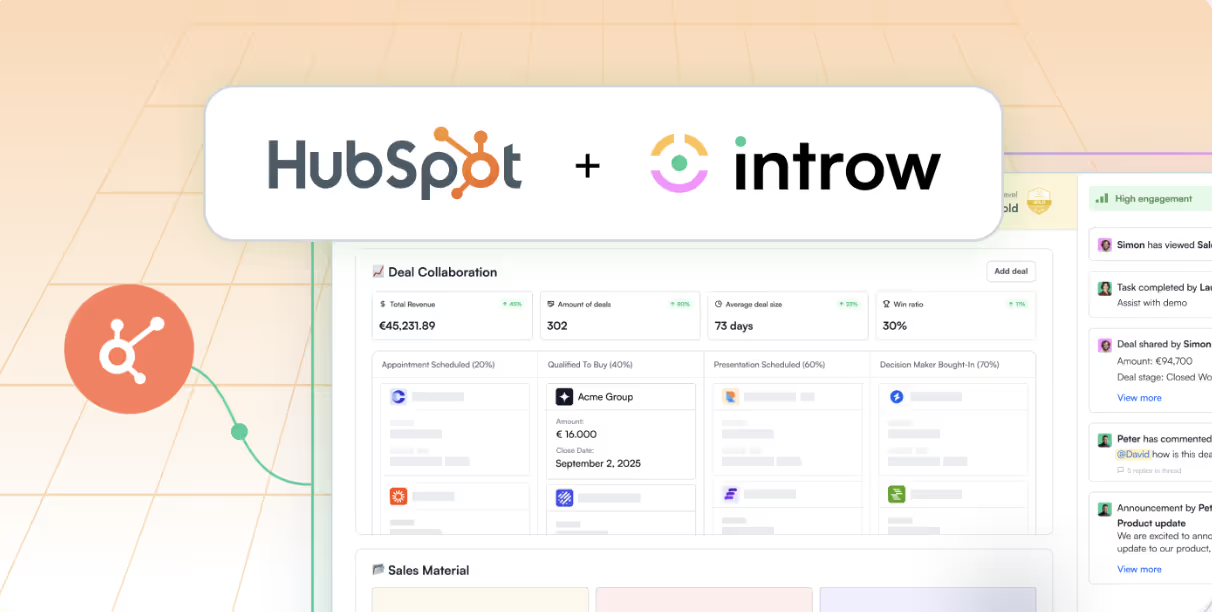
Step-by-Step: How to Build a Channel Partner Program
So, we know why implementing robust partner programs is essential for many SaaS brands in 2025, and you've established that your business is primed to build one.
Here's how to build a channel partner program.
1. Define Your Partner Types
Start by clearly identifying the types of partners that best support your go-to-market goals.
These may include:
- Resellers who sell your product directly
- Referral partners who generate leads
- Technology alliances that integrate with your platform
- Managed service providers (MSPs) that offer bundled solutions
2. Design Your Incentive Structure
A well-structured incentive program is central to any modern partner program.
Due to the nature of partnerships, appealing incentives are the only impactful tool you have for motivating partner performance and aligning their efforts with your company's revenue goals.
Begin by deciding on core components such as:
- Commission rates
- Tiered benefits
- Performance-based rewards.
Set clear performance goals tied to strategic outcomes, and ensure alignment with your Chief Revenue Officer (CRO) and/or your Chief Customer Officer (CCO) to maintain focus on pipeline quality, ARR growth, and customer success.
Get your incentives right, and you should be able to drive partner behaviour and strengthen mutual accountability and long-term value creation.
3. Build Your Deal Registration Process
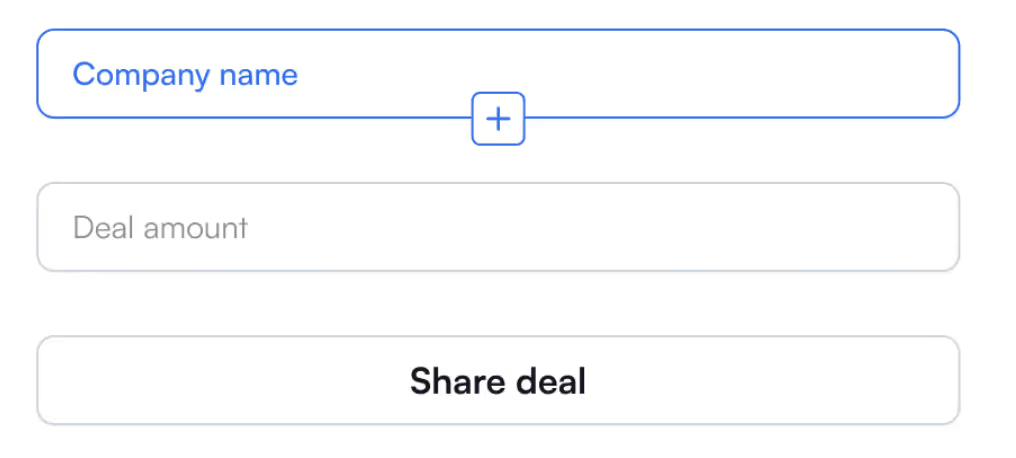
An efficient and friction-free deal registration process drives partner engagement and prevents channel conflict.
Start by creating a simple, user-friendly registration form that captures key deal information without overwhelming your partners.
Make sure the process is fast, intuitive, and clearly communicates the benefits of registering deals, such as deal protection or priority support.
To streamline operations, auto-map the registration system directly to HubSpot PRM or Salesforce PRM — automatically sending partner-submitted data to your sales pipeline.
In addition to slashing manual data entry, this integration also gives your revenue teams real-time visibility into partner-sourced opportunities, improving forecasting accuracy and cross-functional alignment.
📚 Read more: Top 10 Partnership Trackers: Driving Co-Sell Revenue in 2025
4. Enable Partner Engagement Tracking
To manage and optimize partner relationships effectively, you need clear visibility into engagement activity.
It's essential to gain visibility over:
- Emails
- Meetings
- Shared files
- Partner responses throughout the sales cycle
While once upon a time, this engagement tracking would have been a tedious time drain, in 2025, it can be super simple with the right tech stack.
Ensure your communication tools integrate with your PRM and customer relationship management (CRM) platform for centralized data, easy tracking, and a unified view of partner interactions.
For example, the Introw PRM boasts a super useful Slack integration.
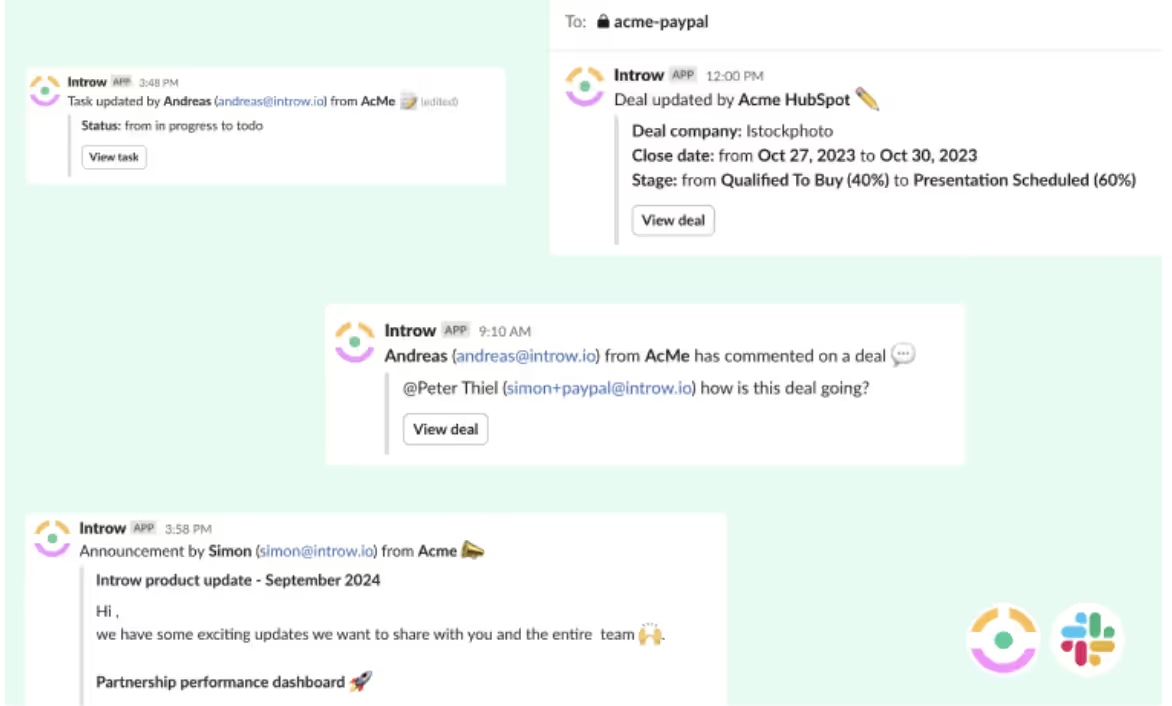
Engagement tracking helps identify your most active and productive partners, enabling your team to strategically prioritize support and resources.
It ensures alignment across sales and marketing efforts and RevOps by making partner activity transparent, measurable, and actionable.
5. Set Up Real-Time Forecasting & Reporting
Ditch static spreadsheets and move to real-time, CRM-native forecasting to gain accurate, up-to-the-minute insights into partner performance and pipeline health.
By pulling data directly from your CRM, you ensure consistency, reduce manual errors, and save valuable time.
Real-time dashboards can display key partnership metrics such as:
- Deal stage progression
- Partner-contributed revenue
- Forecasted ARR
- Partner tier performance
This high level of visibility empowers both your partners and your RevOps teams to make data-driven decisions quickly, and helps to align cross-functional stakeholders, including your CRO and CCO, around shared revenue targets.
It also empowers channel managers to identify underperforming areas early and swiftly take action to adjust strategies or provide extra resources.
In short, real-time forecasting transforms your partner program into a measurable, predictable growth engine.
6. Create a Repeatable Co-Selling Motion
A structured, repeatable co-selling process is key to turning partnerships into pipeline.
Indeed, running disjointed or unstandardized partnership processes is a quick way to lose partners and prospects and waste time and money.
So, how can you create a repeatable co-selling motion?
Begin by establishing regular joint pipeline reviews with your partners to align on deal status, next steps, and mutual priorities.
Use these sessions to identify blockers, share insights, and reinforce accountability on both sides.
Implement mutual action plans for key deals — clearly outlining responsibilities, timelines, and partner success criteria for each party.
This keeps everyone focused and reduces deal slippage.
To scale co-selling effectively, invest in a PRM platform like Introw that integrates with your CRM.
A strong PRM centralizes your partner information and enables the tracking of joint opportunities, document sharing and communication, ensuring nothing falls through the cracks.
Using your PRM, it's easy to set up standardized processes for partners within your PRM, ensuring the same workflows are followed, and the same milestones are hit from the start to the end of the sales cycle.
By standardizing your co-selling motion, you not only drive consistent results but also create a more predictable, scalable path to revenue — turning ad hoc collaboration into a high-performance engine for growth.
7. Launch Your Partner Portal or Experience
It's time to launch your partner portal!
Modern partner engagement requires a frictionless, branded experience — this is where your partner portal comes in.
For instance, Introw offers a modern, user-friendly partner portal that simplifies and enhances collaboration between businesses and their partners.
The portal is fully white-labeled, allowing companies to customize it with their branding.
Another standout feature is the no-login-required access, enabling partners to interact with the portal through secure links via email or Slack.
This approach reduces friction, making it easier for partners to register deals, access resources, and stay engaged without the hassle of managing additional login credentials.

What's more, the portal integrates seamlessly with popular CRMs like Salesforce and HubSpot, ensuring that all partner activities are automatically synced, providing real-time visibility into the sales pipeline and partner performance.
Further reading: Here's everything you need to know about choosing Your Next PRM
8. Run Ongoing Reviews and Optimize
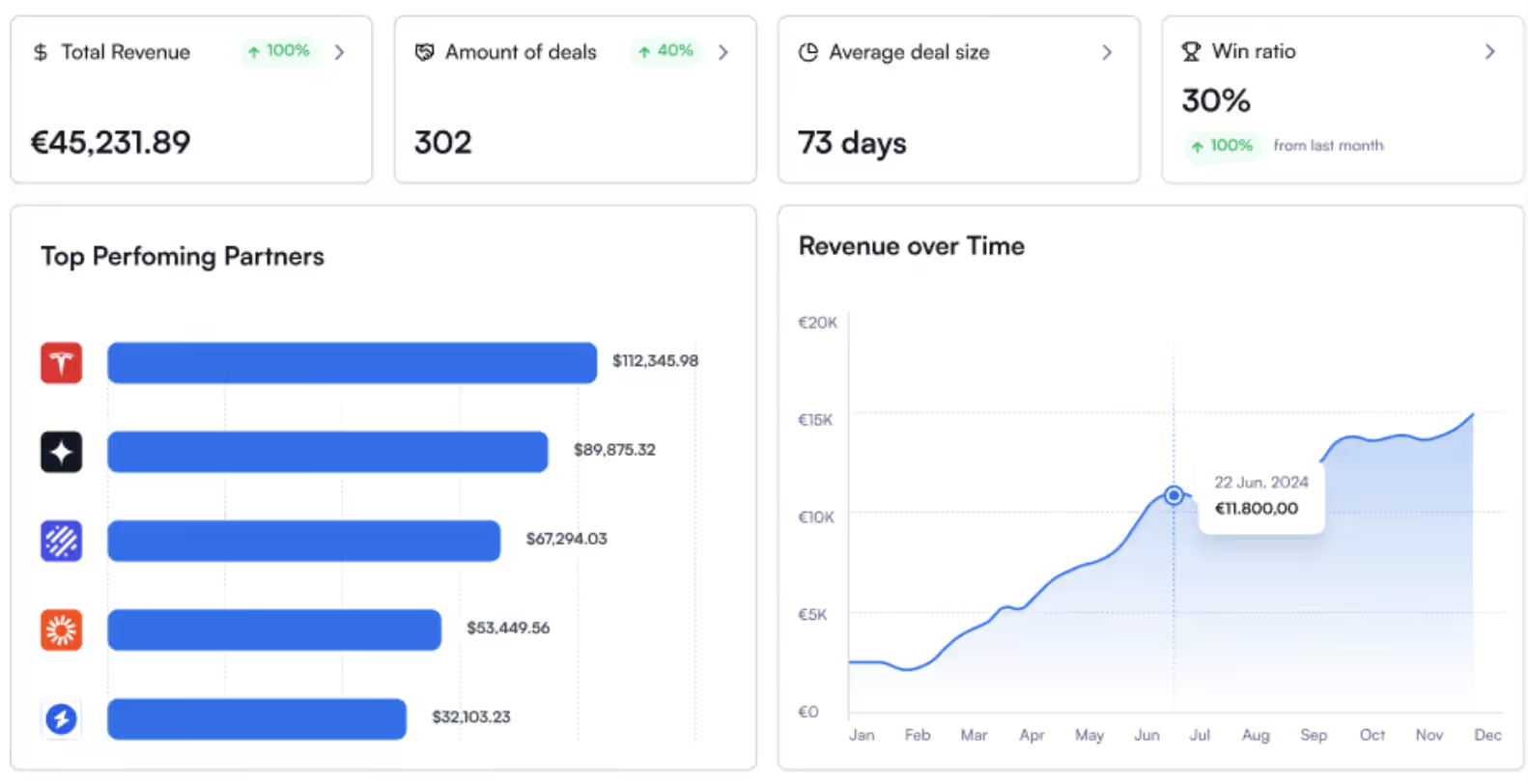
Building a successful partner program isn't a one-time effort — it requires continuous evaluation and improvement.
To build agility and responsiveness into your program, establish monthly review sessions with key partners to assess performance, pipeline health, and alignment with mutual goals.
Use Mutual Action Plans and clearly defined KPIs to guide these reviews, focusing on metrics like deal velocity, close rates, and partner-sourced revenue.
These sessions should provide your business and your partners with a forum to identify what's working, uncover bottlenecks, and refine strategies collaboratively.
It's crucial to ensure alignment with your Chief Revenue Officer and RevOps team, too, so that partner activity is directly tied to overall revenue outcomes and forecasting.
Think of it this way — regular reviews turn your channel into a living, evolving asset that consistently delivers results.
Channel Partner Program Best Practices (2025)
So, when building a strong, modern channel partner program, which best practices produce the best channel partner programs?
1. Operational Excellence for RevOps
RevOps plays a critical role in driving the efficiency and scalability of your channel partner program.
To deliver operational excellence, start by ensuring that you have clean, consistent CRM data — accurate partner attribution, deal stages, and source tracking are essential for reporting and forecasting.
Then, implement structured partner segmentation.
This segmentation allows you to personalize your engagement, enablement, and incentives based on partner type, performance, and potential for better results — saving you time while driving engagement.
Furthermore, to achieve true operational excellence in 2025, you will need an outstanding and thoughtfully-assembled tech stack.
You can leverage no-code tools to automate workflows, integrate systems, and scale processes — empowering you to scale without heavy reliance on technical support.
2. Keeping Partners Engaged
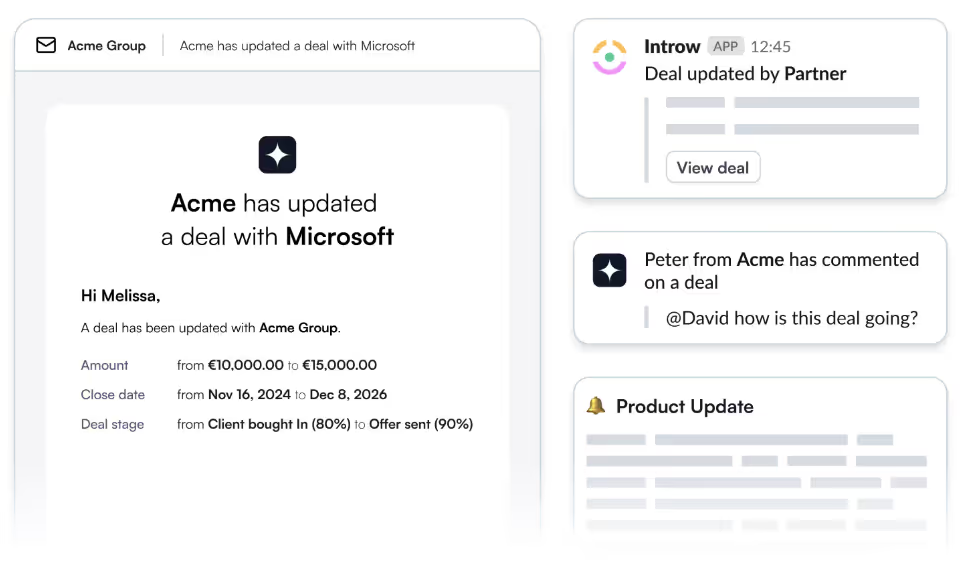
Sustained engagement is key to a successful channel partner program.
Indeed, timely, relevant communication keeps your solution top-of-mind and builds trust over time.
It's crucial to use communication and engagement tools that integrate with your partner portal — such as email or Slack — to streamline communication.
A strong level of communication surrounding deal progress, next steps and mutual responsibilities provides much-needed visibility into the shared pipeline, ensuring partners stay informed.
Think instant notifications for new leads, updates, or closed deals.
Consistent, transparent updates turn partners into proactive, invested collaborators, driving more pipeline and stronger results.
3. Building for Scale, Not Chaos
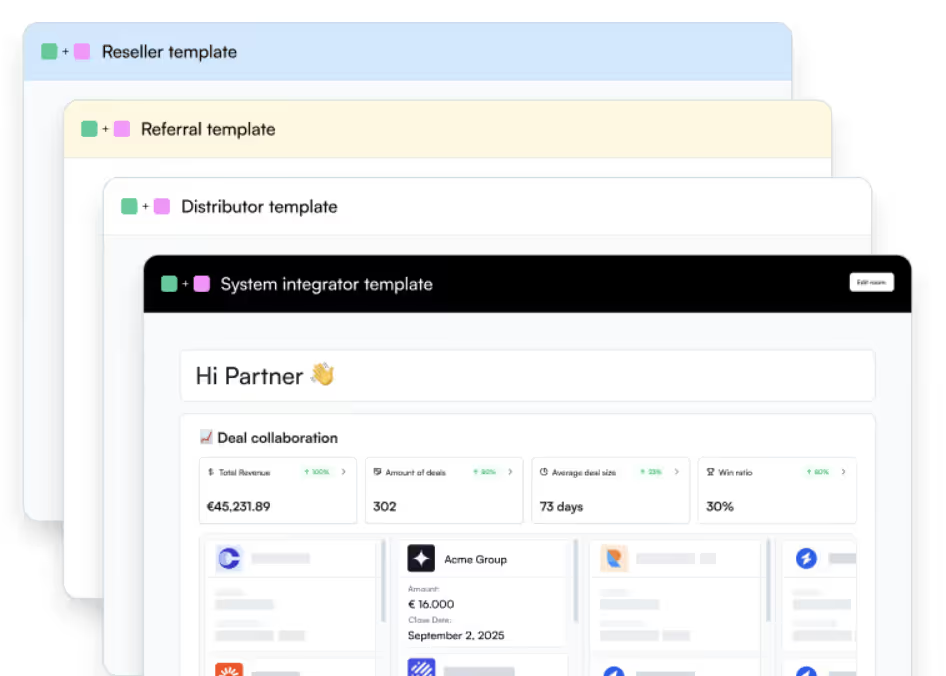
As your partner program grows, consistency becomes critical, and the risk of chaos rises!
Constructing a scalable foundation not only accelerates growth but also allows your team to focus on strategy rather than chasing down processes or managing one-off exceptions.
So, how can you ensure you're building for scale rather than running headfirst into operational chaos?
Start by creating standardized templates for key processes — like onboarding, deal registration, co-selling, and reporting.
These templates will save you time, reduce errors, and make it easy to bring on new partners without reinventing the wheel.
At the same time, you can use your PRM, CRM, and communication tools to customize workflows and content based on partner type, maintaining flexibility and ensuring relevance while preserving operational flexibility.
📚 Read more: 10 Best Practices for Channel Management
Common Pitfalls to Avoid
As with any large project, most SaaS companies will face several challenges while implementing their channel partner program.
Here are the pitfalls to look out for and avoid.
1. Manual Systems Outside the CRM
Relying on spreadsheets, email threads, or disconnected tools to manage partner activity creates inefficiencies, errors, and data silos.
These manual systems make it difficult to track deal status, attribute revenue accurately, or forecast effectively.
Worse, they hinder collaboration between sales and partnerships teams.
Centralizing all partner data and workflows inside your CRM through integrations and a CRM-first PRM like Introw ensures real-time visibility, better alignment, and a scalable foundation for long-term business growth.
2. One-Size-Fits-All Portals
Generic partner portals often fall short by failing to meet the unique needs of different partner types, and a lack of branding can also cause a drop in trust.
Furthermore, without tailored experiences, engagement drops and partners struggle to find relevant resources.
Customizing content, workflows, and portal access based on partner roles ensures higher activation, better collaboration, and a more productive, scalable ecosystem.
Meanwhile, the option for branded portals should help to build partners' trust in your business.
3. Misaligned Incentives or Comms
Engagement and performance suffer when incentives or communication strategies don't align with partner goals.
For example, overly complex rewards or unclear messaging can lead to confusion and missed opportunities.
Instead, ensure that incentives are simple, outcome-driven, and well-communicated.
Regularly sync with partners to reinforce alignment and keep both sides focused on shared revenue and success.
How Introw Simplifies Every Step
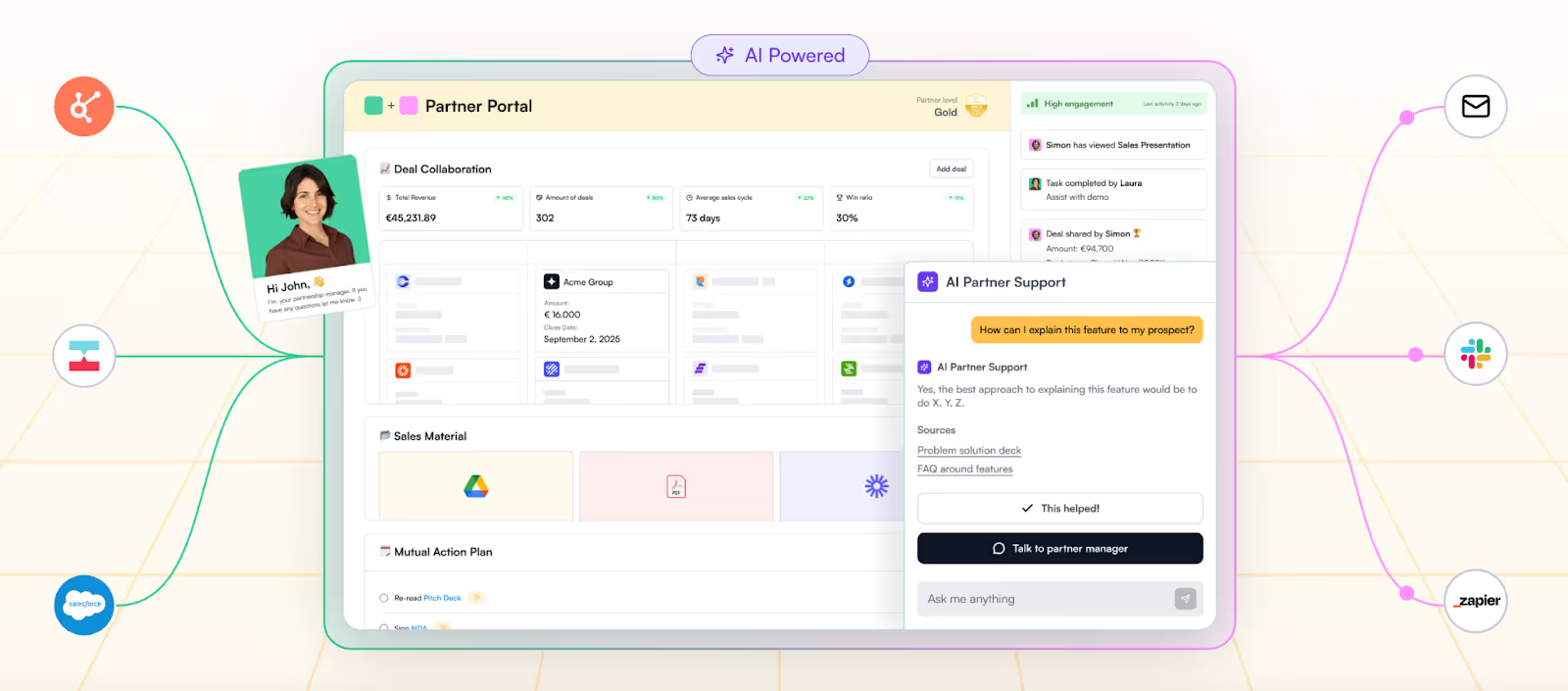
Building a channel partner program may sound complex, but — with the right PRM — it can be pretty straightforward.
Here's what Introw brings to the table.
- CRM-first experience (no toggling): Introw keeps your CRM as the single source of truth, eliminating the need to switch between multiple platforms. Integrating directly with systems like Salesforce and HubSpot ensures that all partner activities are centralized, streamlining workflows and reducing manual data entry.
- Auto-synced lead/deal tracking: Leads and deals submitted by partners are automatically detected and tracked within your CRM. This ensures real-time visibility into partnership revenue and eliminates the need for manual updates.
- Off-portal engagement: Partners can submit leads, collaborate, and stay updated via Slack, email, or shared deal workspaces, all of which are seamlessly synced to your CRM. Or, they can enter the Introw partner portal to find all the resources they need.
- Custom partner journeys: Automate and customize partner journeys based on partner type or tier. This enhances engagement by delivering relevant content and interactions.
- Forecasting built into your CRM: By integrating partner data directly into your CRM, Introw enables real-time forecasting and reporting. This integration provides accurate insights into partner performance and pipeline health, facilitating data-driven decisions and aligning partner activities with overall revenue goals.
📚 Further Reading: Find The Best PRM Software For Your Agency
Ready to Scale Your Channel in 2025?
Is your SaaS business ready to build your own channel partner program?
To recap, here's how to start benefiting from your partnerships in eight straightforward steps:
- Define your partner types
- Design your incentive structure
- Build your deal registration process
- Enable partner engagement tracking
- Set up real-time forecasting and reporting
- Create a repeatable co-selling motion
- Launch your partner portal or experience
- Run ongoing reviews and optimize
In 2025, cutting-edge tech tools make the process of operating partner programs much smoother and way more scalable.
Introw helps SaaS companies launch, manage, and scale high-performing partner ecosystems — without the complexity.
From CRM-native deal tracking to no-login partner experiences, Introw gives you everything you need to activate partners and drive revenue from day one.
This PRM is perfect for SaaS brands that use HubSpot, Salesforce or Slack.
🚀 Book a live demo today and start building a partner program your CRO will love
📚 Next Read: The Ultimate Partnership Marketing Guide for 2025: Strategies, Examples & Tips
The 4 ways to manage your B2B partners in Salesforce and attribute revenue
When working with B2B partners, it's important to have a clear way of tracking who’s involved in your opportunities and how they contribute to revenue. In Salesforce, there’s no one-size-fits-all method — and that’s the beauty of it. Depending on your organization’s needs, technical maturity, and the complexity of your partner ecosystem, you can choose from several flexible approaches.
Below, we break down 4 common ways to manage partners in Salesforce and attribute revenue to them effectively.
1. Picklist field on an Opportunity
Best for: Simpler programs with one partner per Opportunity
The most straightforward method is to add a picklist field to the Opportunity object — for example, a field called Partner Name or Partner Source. You pre-define a list of your partners and let your sales team select the right one during opportunity creation.
How does it work?
What are the pros?
✅ Easy to implement
✅ No complex relationships needed
✅ Good for easy single-partner attribution
What are the cons?
❌ Not ideal for scaling or multi-touch attribution
2. Lookup field to an Account object Recommended
Best for: One-to-one attribution with better data control
A step up from a picklist is using a lookup relationship field that connects an Opportunity to an Account object. This allows you to reference a full account record (your partner) and pull in relevant details automatically.
How does it work?
What are the pros?
✅ Clean reference to partner data being stored in your accounts
✅ Can support reporting and automation more effectively
✅ Easy to update if the Account record changes
What are the cons?
❌ Limited to one partner account per opportunity
3. Via a Relation table
Best for: Multi-partner attribution or shared deals
If you need to support multiple partners per opportunity, you’ll want to use a relation table that sits between Opportunities and Partner Accounts. This creates a many-to-many relationship, enabling flexible collaboration and advanced revenue sharing logic.
How does it work?
What are the pros?
✅ Ideal for ecosystems with resellers, distributors, and co-marketing partners
✅ Enables advanced logic for revenue splits or co-selling
✅ Ideal for ecosystems with resellers, distributors, and co-marketing partners
What are the cons?
❌ Requires a more technical setup and configuration
❌ More complex for reporting unless standardized
4. Custom Object for Partners
Best for: Large-scale partner programs with tiering, statuses, and multiple partner touchpoints
For organizations that want to treat their partners as a core part of the Salesforce data model, creating a dedicated Partner object is the most robust option. You can relate this object to Opportunities, Contacts, Accounts, and more — and track custom partner attributes like tier, region, industry focus, etc.
How does it work?
What are the pros?
✅ Fully flexible and scalable
✅ Allows for richer partner data and automation
✅ Better suited for partner performance analytics and program insights
What are the cons?
❌ Requires upfront planning and schema design
❌ Needs buy-in from operations and potentially dev teams
Conclusion
Choosing the right method to manage and attribute your B2B partners in Salesforce depends on the complexity of your partnerships and the level of reporting or automation you need. While simple picklists work for early-stage programs, relation tables or custom objects are better suited for mature ecosystems.
At Introw, we help customers integrate their partner workflows directly into Salesforce — making it easy to attribute, collaborate, and scale with partners, no matter which method you use.
👉 Curious how this would work in your setup? Request a demo now.


.svg)





















